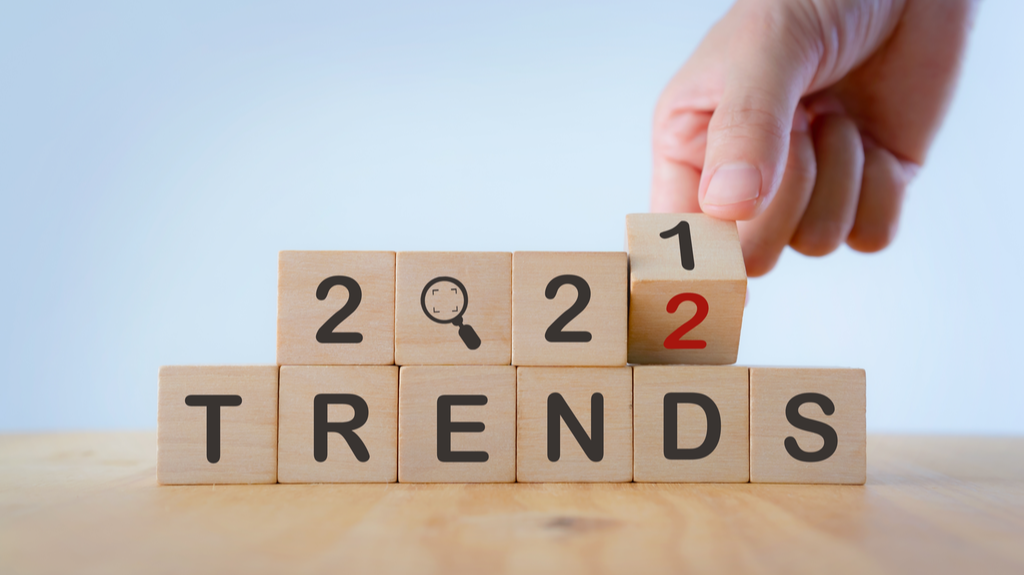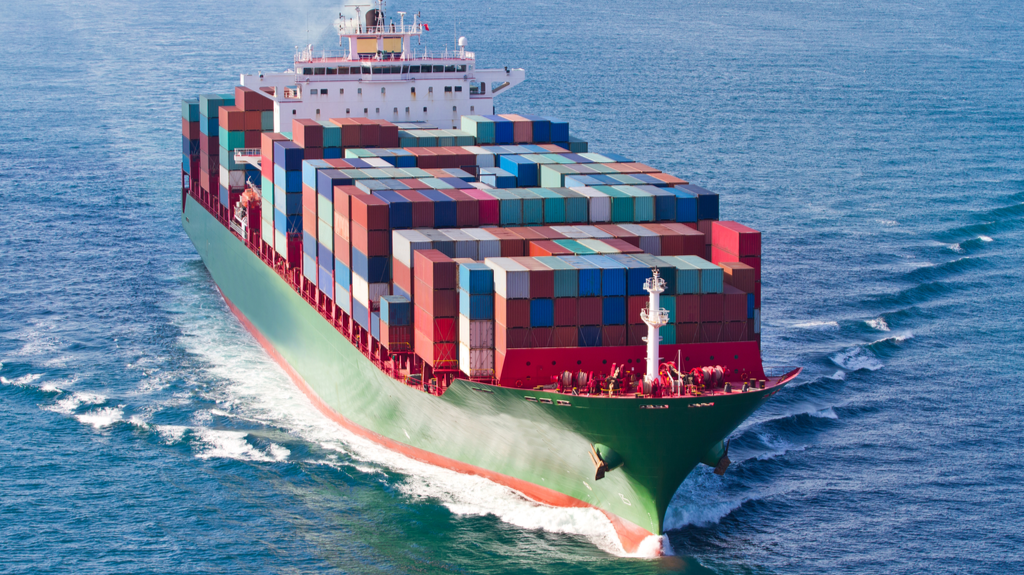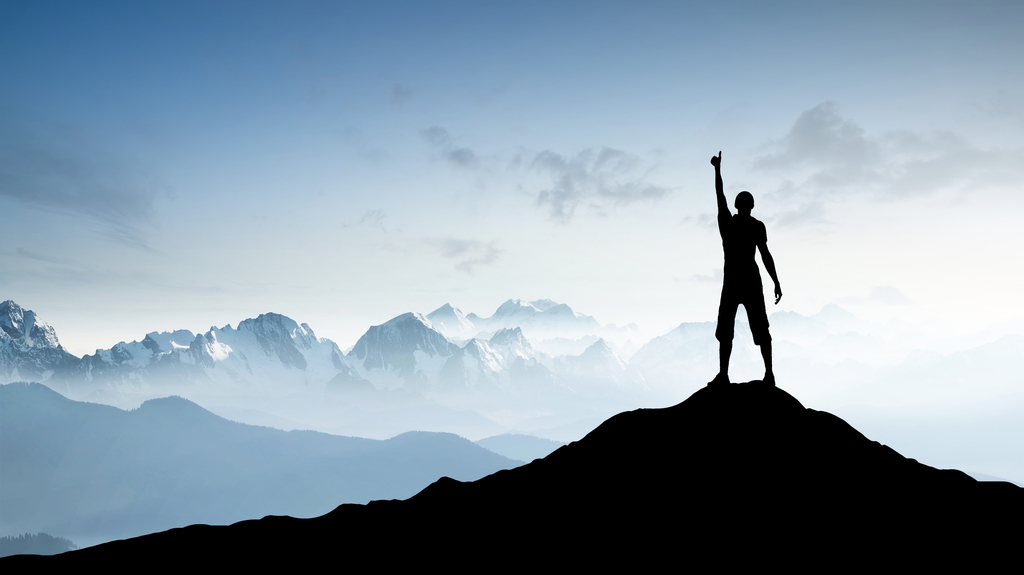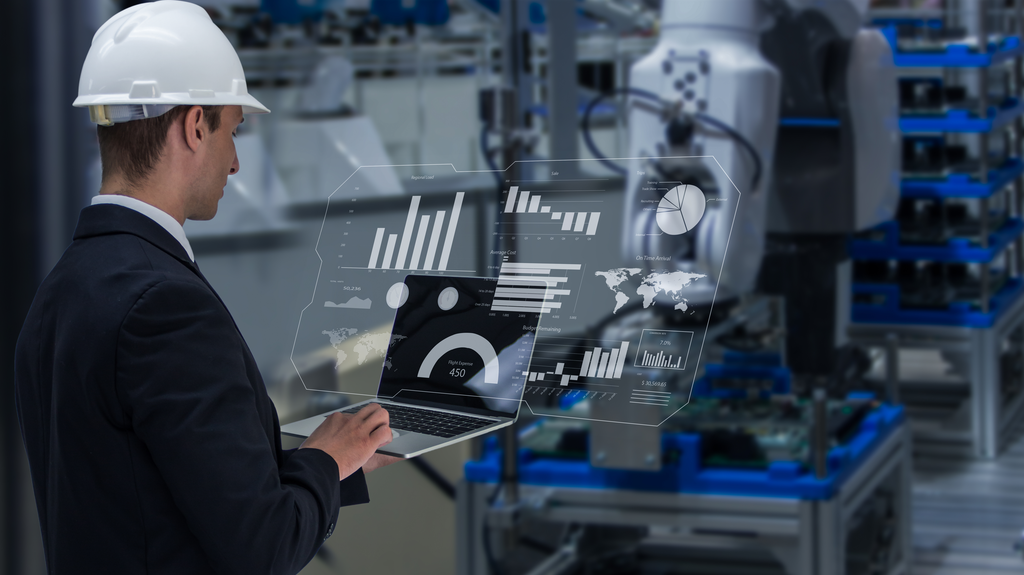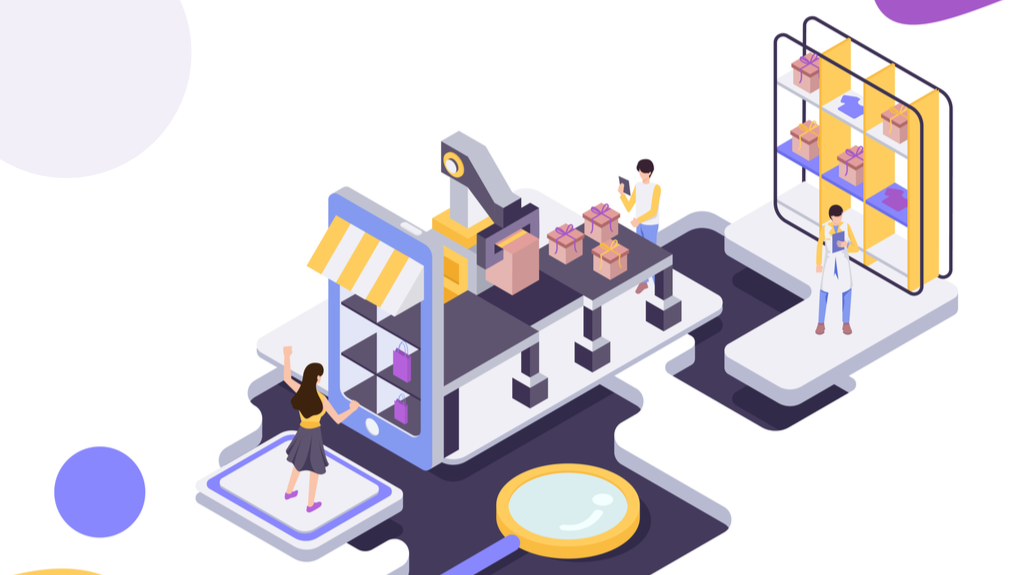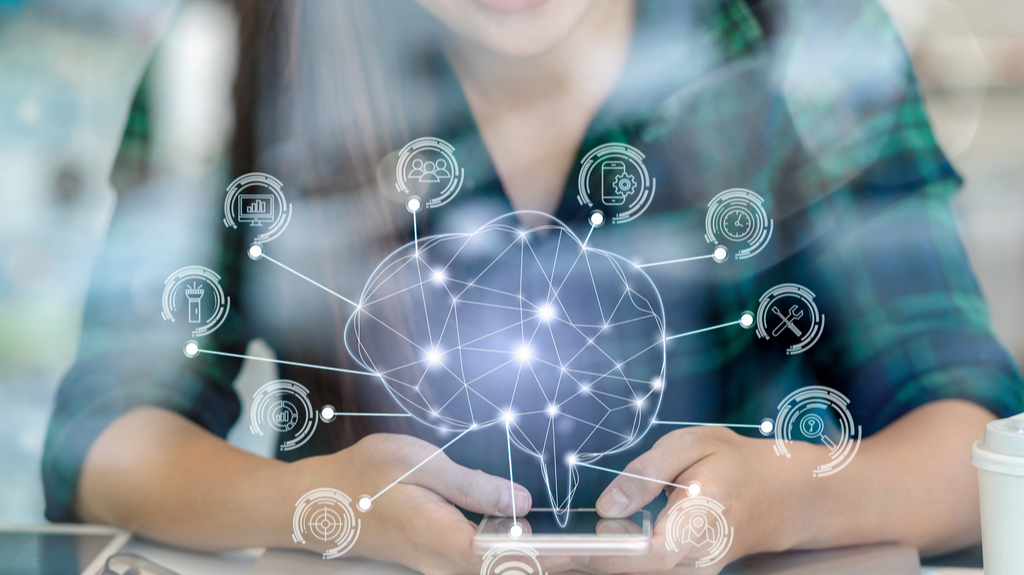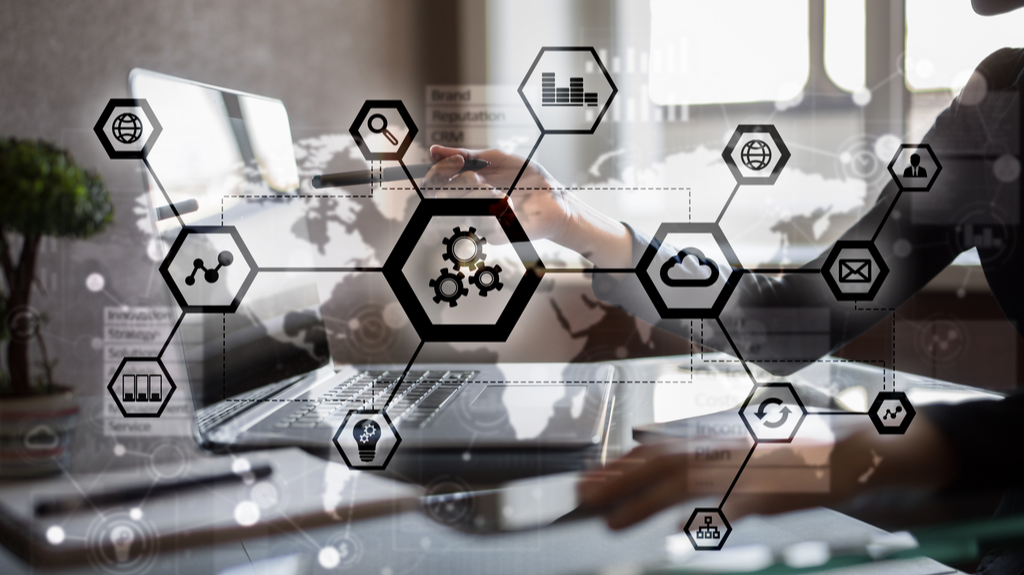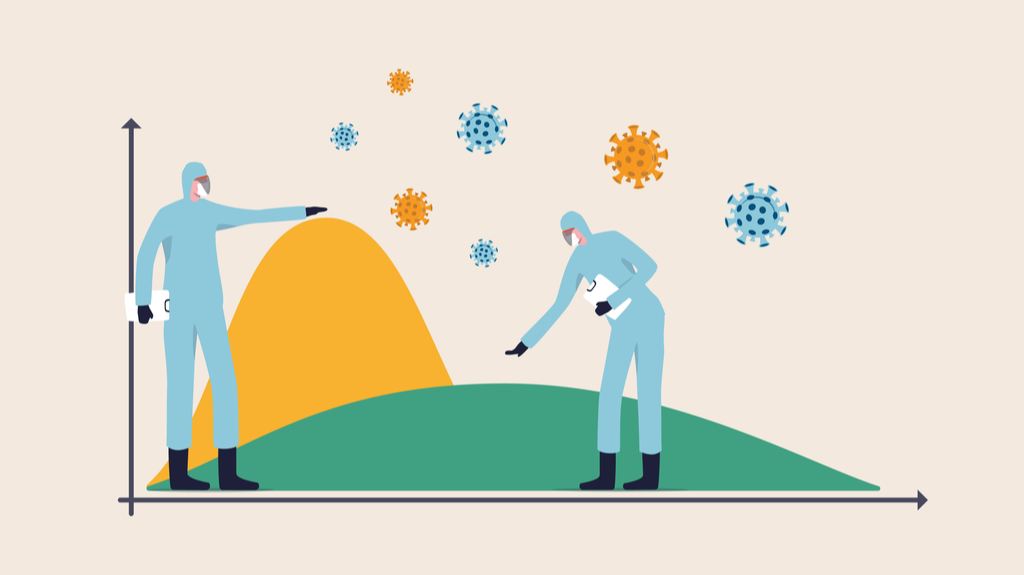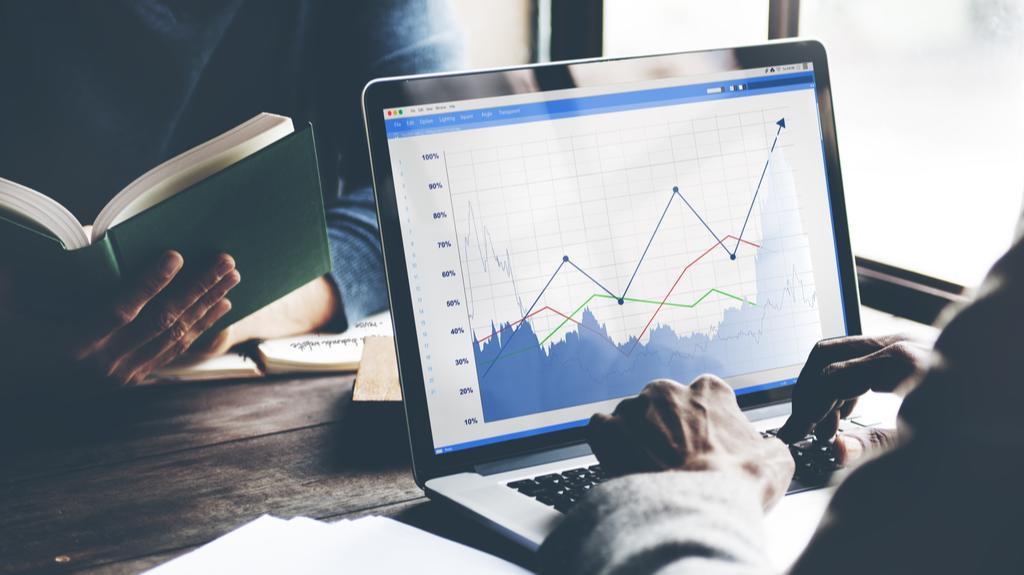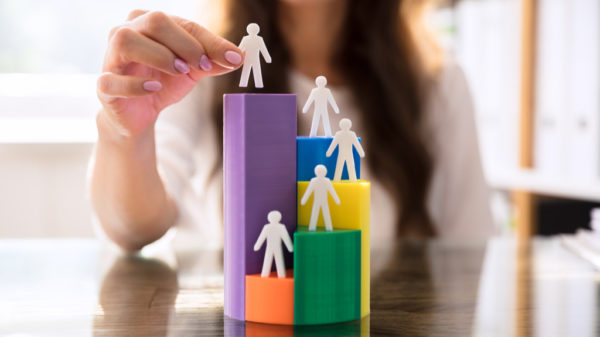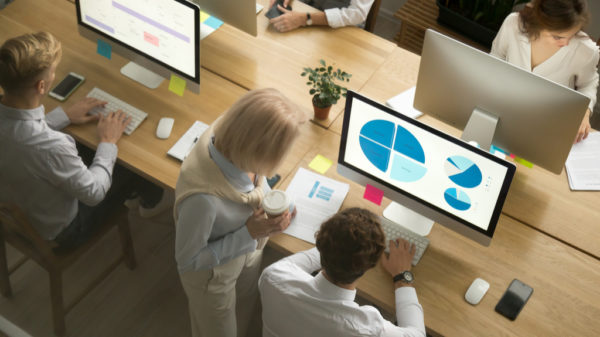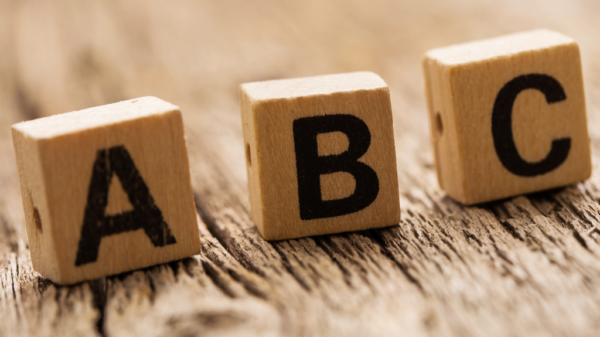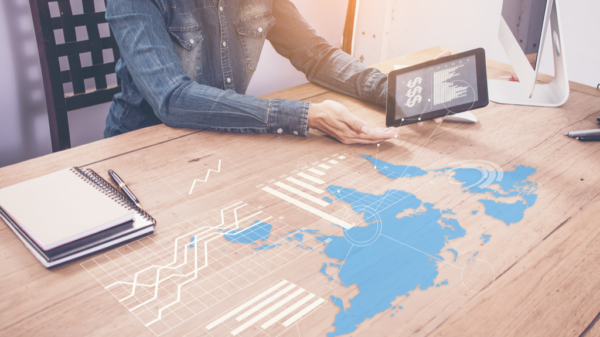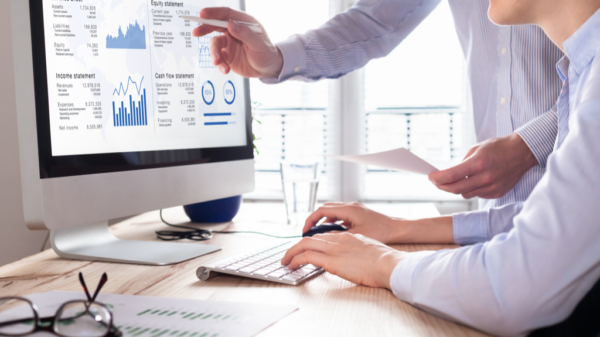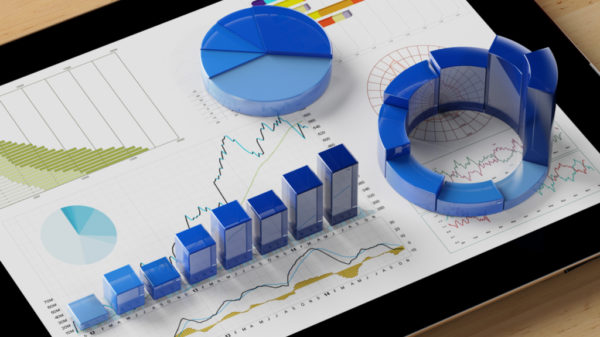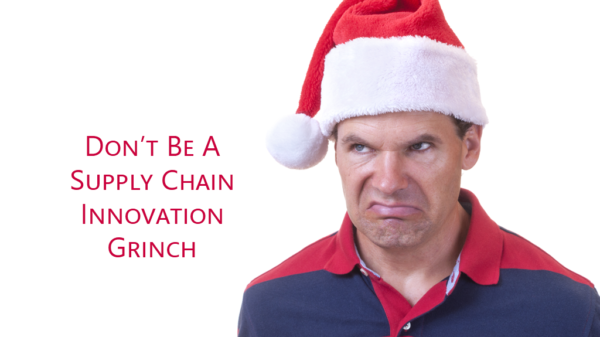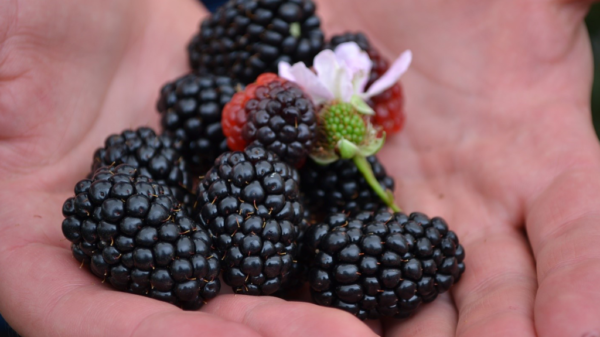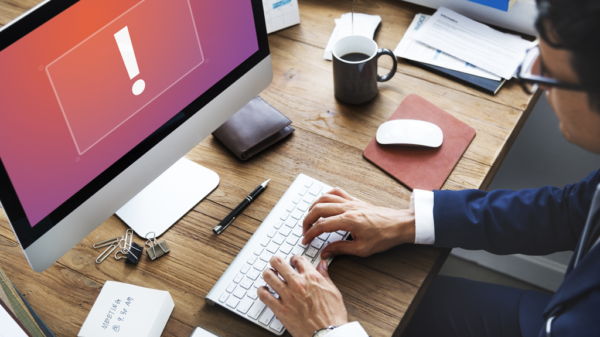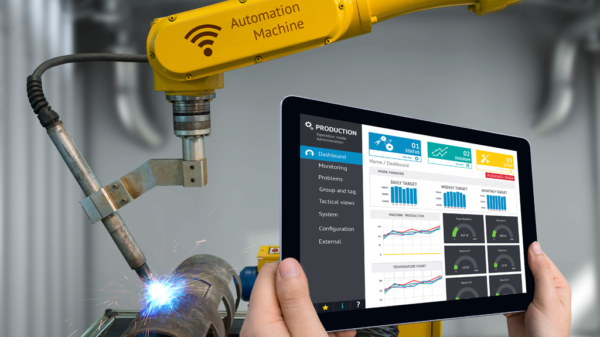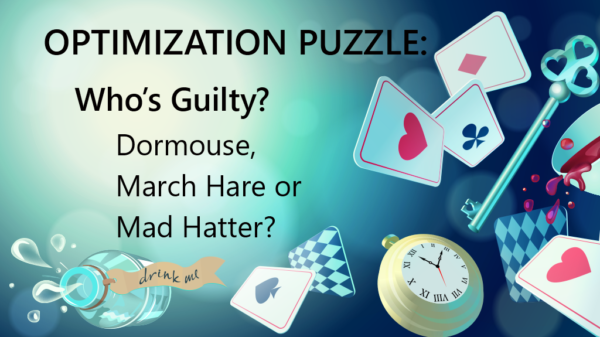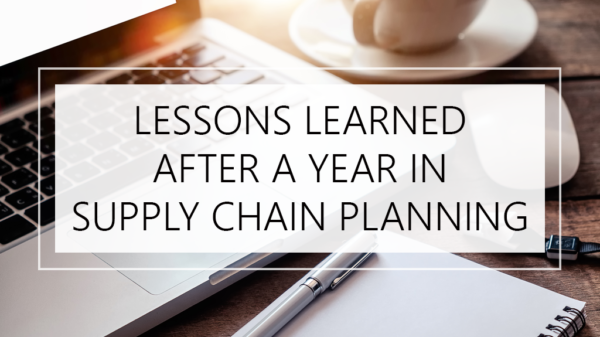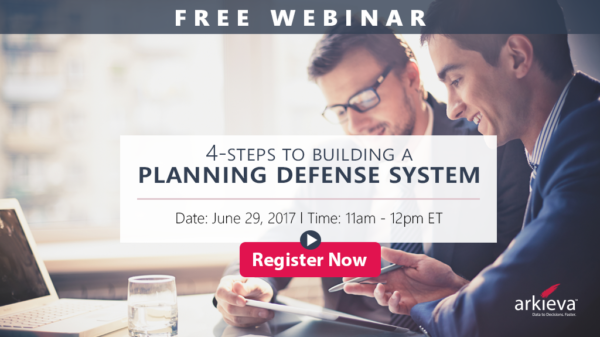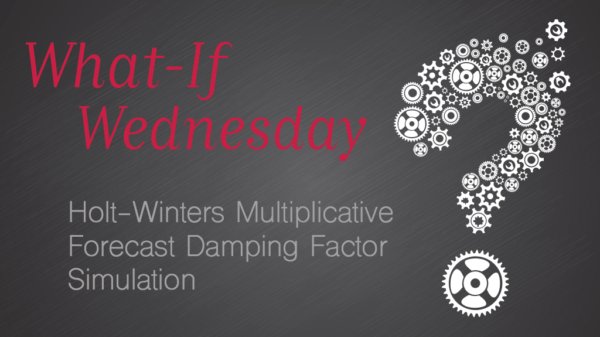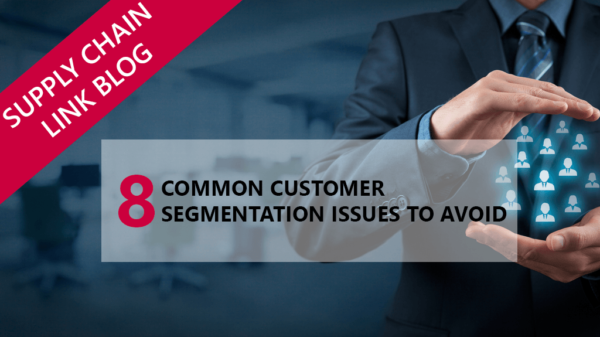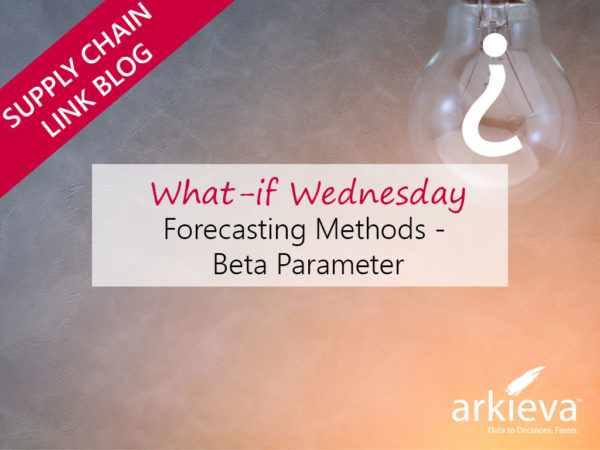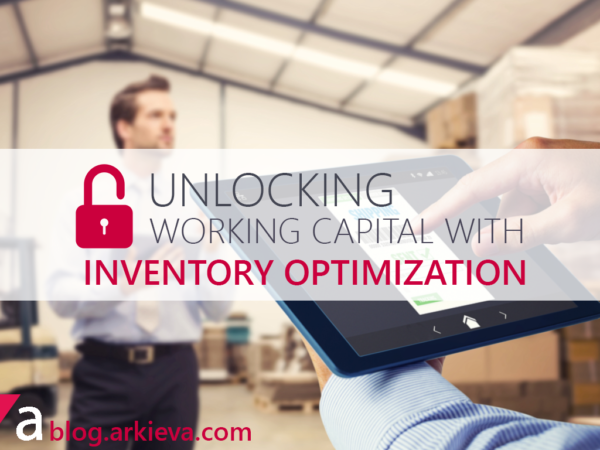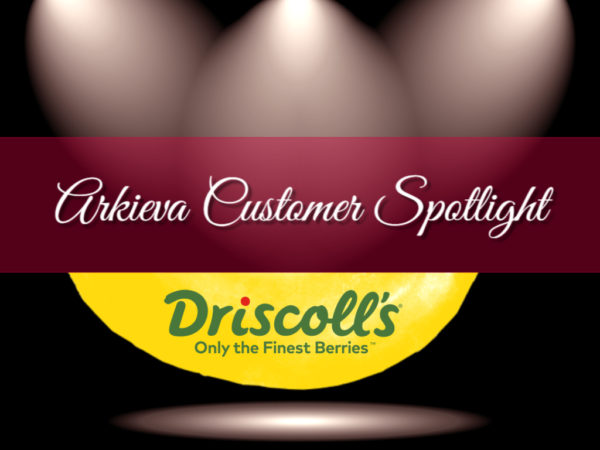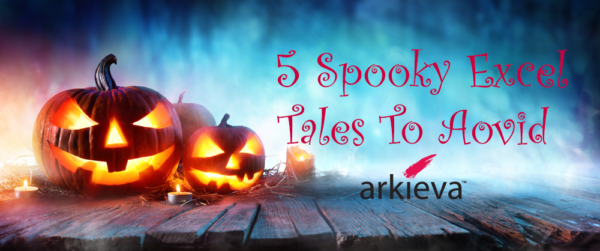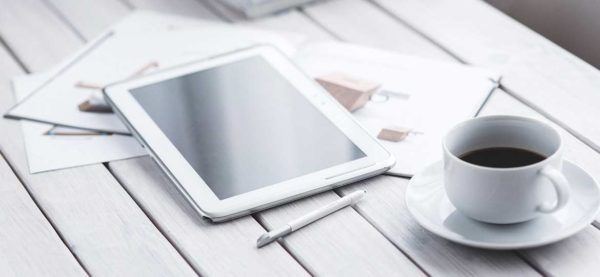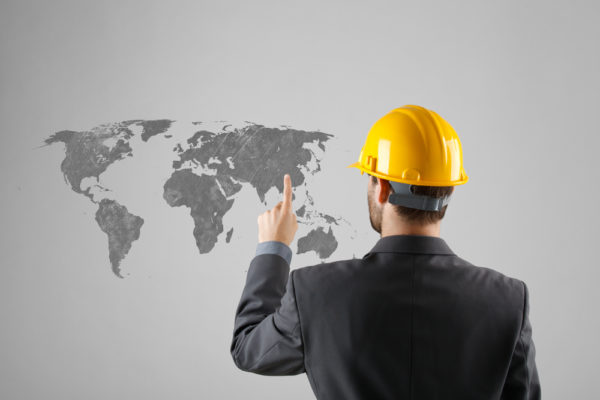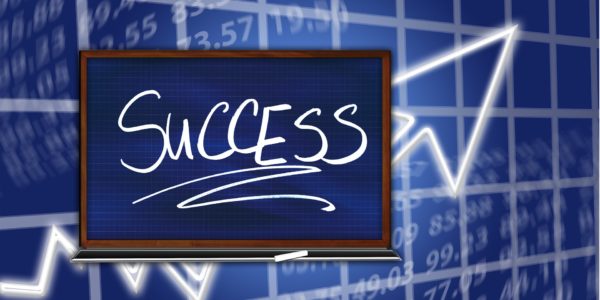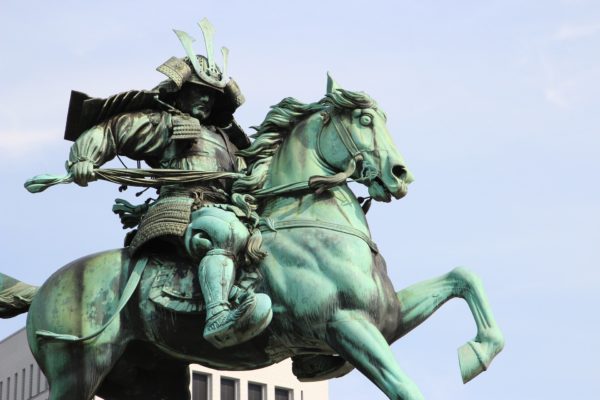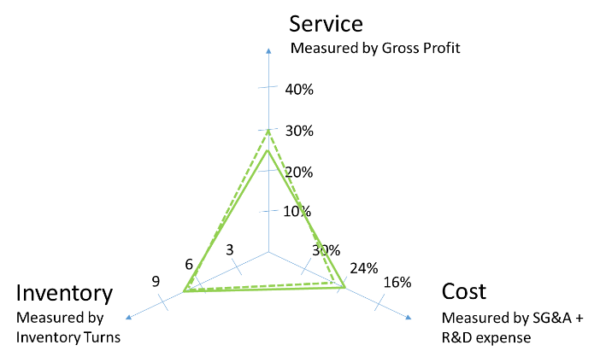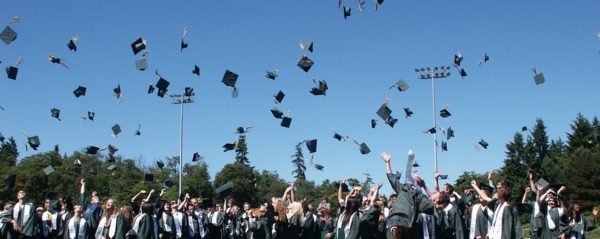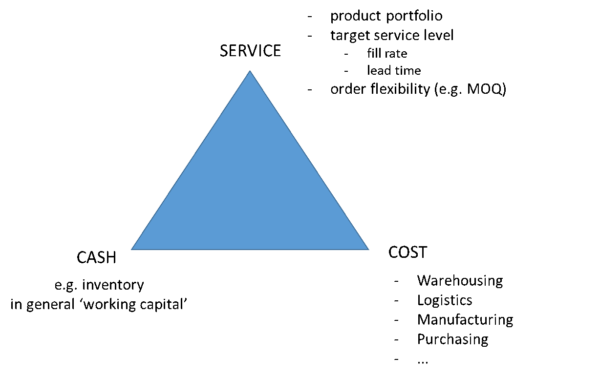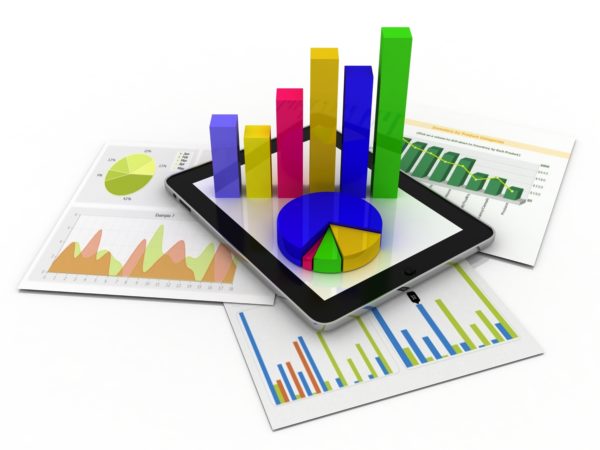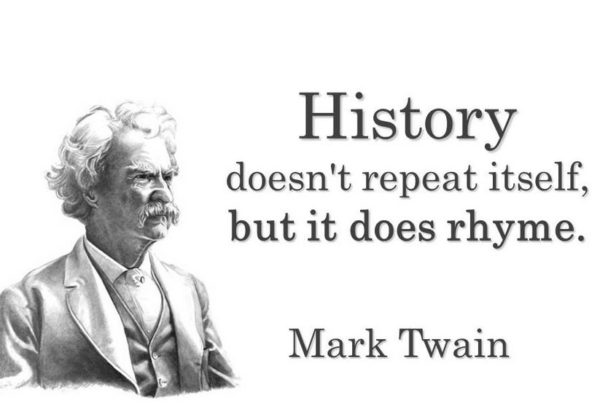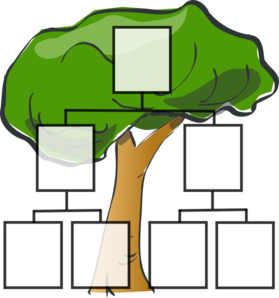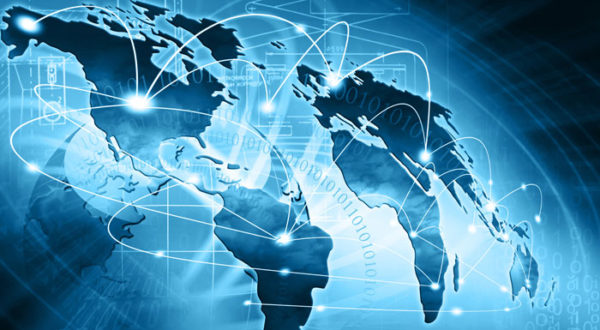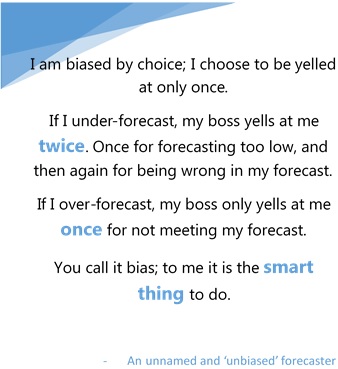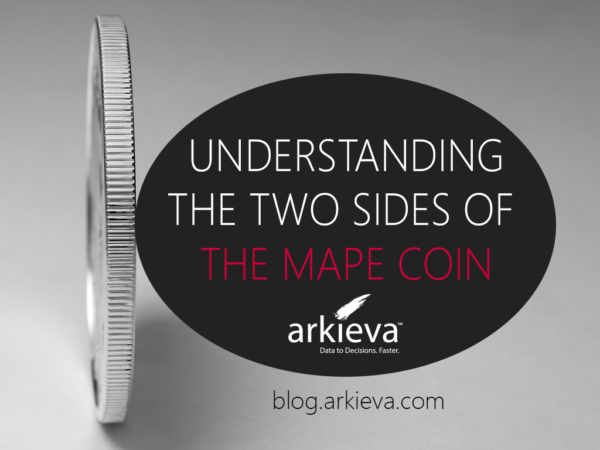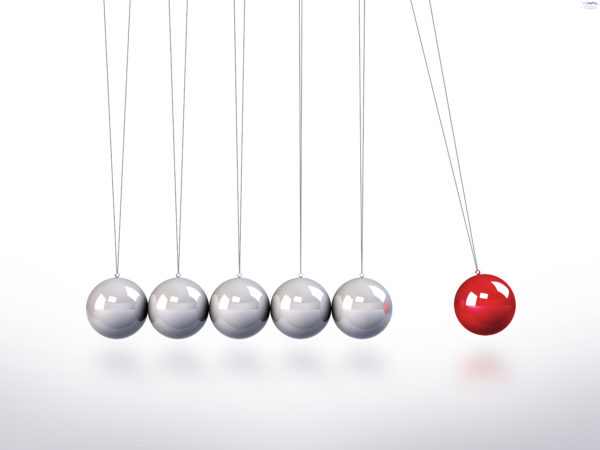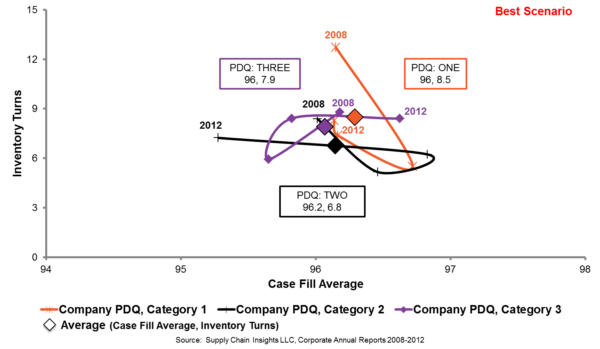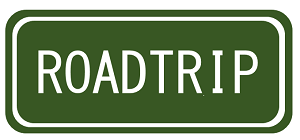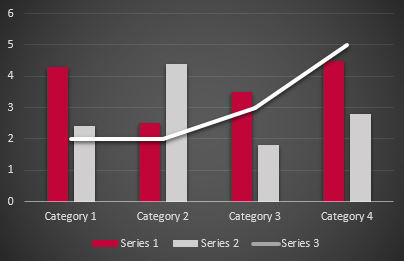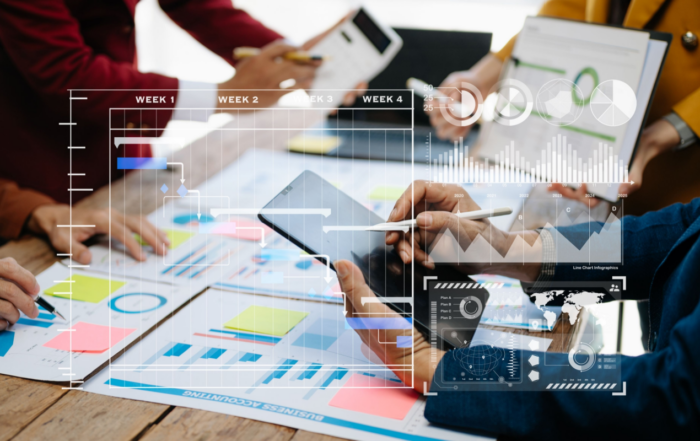Arkieva Supply Chain Link Blog.
Creating the link between better supply chain planning and decisions.

Building the Business Case for Supply Chain Planning Software Implementation
Calculating expected benefits and demonstrating ROI for supply chain planning software implementations are critical. Attend our webinar and learn how.
Essential Concepts for Successful Responsiveness: Planning versus Scheduling Basics
Understanding the difference between planning and scheduling basics will help achieve responsiveness which is increasingly important in the ever-changing world.
4 Common Production Scheduling Problems that the Right Software Solves
Minimize changeover time and maximize utilization and production efficiency. Avoid common production planning and scheduling software missteps.
What the Economic Outlook Means for Demand Planning
Forecast as accurately as possible, even in uncertain economic conditions. Review demand planning strategies that can help you navigate hazy market conditions.
Avoiding the Assumption of Normal Distribution in Safety Stock Calculations
Explore alternatives beyond the norm in the world of safety stock calculations. Join our webinar to break free from distribution assumptions.
Arkieva Named Challenger in 2024 Gartner® Magic Quadrant™ for Supply Chain Planning Solutions
Arkieva recognized as Challenger in 2024 Gartner Magic Quadrant for Supply Chain Planning, empowering businesses with cutting-edge solutions.
Unwrapped: What You’ll Take Away from the 2024 Gartner Supply Chain Symposium
Make the most of your time at the 2024 Gartner Supply Chain Symposium/Xpo in Orlando. Preview the can’t-miss speakers and supply chain planning topics.
The Latest R in Sustainability: Reshoring
As awareness of climate change and globalization grow, the list of Rs in sustainability is also growing. This blog explores the latest trend: reshoring.
Unpacking S&P Global’s 2024 Supply Chain Industry Outlook
Mitigate supply chain risks. Review our analysis of S&P Global’s 2024 Outlook to assess the challenges and importance of building resilient supply chains.
How to Improve Forecast Accuracy
Forecast accuracy is at the top of the list of things that help a business plan better for the future. This blog previews how to improve forecast accuracy.
A Journey Through Safety Stock, Part 11
This blog is the latest part of the story of Kate and Jane as they navigate the concepts of safety stock at Jane's company and focuses on variance terms.
What is S&OP?
What is S&OP? In a world where you can easily get overwhelmed by the number of supply-chain related acronyms, S&OP is one you don't want to overlook.
An Artificial Intelligence-based Solution to Sudoku
This blog celebrates National Puzzle Day by detailing how to solve a Sudoku puzzle using artificial intelligence.
A Journey Through Safety Stocks, Part 10
This blog continues the journey of Kate and Jane as they navigate the concepts of safety stocks at Jane's company.
Top Reads of 2023: Unveiling Our Most Popular Blog Posts
From insightful industry analyses to practical how-to guides, our blog demonstrates the diverse range of supply chain-related topics we cover.
8 Things that Should be on Every Demand Planning Wish List
Effective demand planning positively impacts everything from production to inventory, distribution to marketing—and all steps in between.
How to Calculate Safety Stock and Evaluate Different Methods
Uncertainty and volatility have been around for decades. There are several methods of leveraging safety stock in the supply chain to mitigate risk.
Using What-if Scenario Planning to Balance Supply and Demand
Scenario planning provides a framework and set of tools to help planners pinpoint risks and opportunities, offer recommendations and more.
Seen and Heard at CSCMP EDGE Supply Chain Conference 2023
Key observations from the Edge Conference for Supply Chain, including the impact of generative AI and the gap in skills that is an outcome of this trend.
Navigating the Pitfalls of Expedited Shipping
In the dynamic supply chain management landscape, one of the most challenging aspects is dealing with the differences between our forecasts and reality.
The Consequences of Complacency
Complacency can quickly make supply chain planning software obsolete. We lose when we "wait and see". Now is the time for investment and improvement.
How to Build the ROI Case for Planning and Scheduling
Planning and scheduling of manufacturing operations can be likened to going on vacation. Our next live webinar builds the ROI case for planning and scheduling.
Planning Ahead: 2024 Business Investment and the ROI of Supply Chain Planning Software
As 2023 comes to an end, it's a good time to plan your business investment strategy for 2024, and that should include supply chain planning software.
Arkieva Helps Fight Childhood Cancer
Arkieva is proud to sponsor Jeff Ondria on his 4th annual Great Cycle Challenge and support efforts to raise money for the Children's Cancer Research Fund to fight childhood cancer.
A Journey Through Safety Stocks, Part 9
This blog continues the safety stock discussion between Kate and Jane as they evaluate historical sales and lead time data.
Boosting Efficiency: The Value of Scheduling Software
Scheduling software is similar to GPS, organizing the movement of items, marking process steps, ensuring expected locations, and optimizing the route.
Understand the Factors Behind Inventory Accumulation by Optimization Models with No Demand
While working with various optimization models, I often encountered situations where the supply chain optimization model would make decisions to produce items even when there was no demand. This blog discusses different scenarios that led to the optimization models producing and storing excess inventory.
How to Achieve Better Operations Scheduling
This blog previews our free webinar where Sujit Singh discusses his learnings from the schedulers and planners he has had the good fortune to work with.
How Does Arkieva Support Client Success?
This blog features a few of our client success stories. Read more to see how Arkieva helps clients achieve their business objectives.
The State of Just-in-time Supply Chains
Prior to Covid-19, a lean, just-in-time global supply chain model was ideal. Fast-forward and you may be wondering - how did the JIT supply chain model fare?
Why Planning Forecasts Are Wrong and What You Can Do About It
Predicting the future is difficult, yet forecasting remains a critical tool for businesses to plan and prepare for what lies ahead.
How Can A $150MM Manufacturer Compete with Larger Players?
Supply chain disruptions can have a higher impact on smaller manufacturers. How can you keep up with Fortune 1000 companies?
A Journey Through Safety Stocks, Part 8
This blog continues the discussion between Kate and Jane as it relates to the unit of measure as the input demand.
How Can Smaller Manufactures Navigate Competitive Supply Chain Planning Pressures?
In the fiercely competitive landscape of manufacturing, companies with revenues ranging from $50 to $250 million often find themselves under pressure from both smaller and larger competitors. This article explores the competitive pressures faced by manufacturers in this revenue range and provides insights into effective strategies for mitigating these factors.
How to Improve Your Statistical Forecast Using Machine Learning
Our latest webinar examines the varying definitions of machine learning and artificial intelligence while discussing how they can be leveraged to improve your statistical forecast.
5 Ways Artificial Intelligence Impacts the Supply Chain
The adoption of machine learning and artificial intelligence is on the rise, but not at the pace of other transformations. Here are a few reasons why.
SOS(C): Shorten Our Supply Chains
What is a shorter supply chain and what are the benefits of shortening a lengthy supply chain? This blog discusses this and more.
Are You Caught in the Middle?
Do you fall into the gray area of companies who require advanced planning capabilities but lack the resources of larger companies? Arkieva+ is for you.
Is Your Supply Chain Effective, Efficient or Neither?
This blog previews our webinar on effective supply chains and the difference between efficiency and effectiveness.
What Stops Businesses from Adopting Planning Software?
Learn common factors that hold companies back from implementing supply chain planning software - according to ChatGPT and our experts.
A Journey Through Safety Stocks, Part 7
This blog continues the discussion with Kate and Jane and covers variance and cycle service level.
A Journey Through Safety Stocks, Part 6
This blog continues Jane and Kate's discussion on safety stocks through the lens of histograms.
Asking “What if?”
Now is the time to ask “what if” we enhanced our forecasting with technology that can work with or replace Excel?
How to Select Effective Dashboard KPIs
This blog previews a webinar that discusses how to find the best data to drive your integrated business planning processes.
Sales & Operations Planning vs Integrated Business Planning
Are you ready to move beyond S&OP to integrated business planning? This blog covers key considerations for implementing IBP.
Why Now is the Time for Arkieva+
Digital transformation has been a prime area of focus over the last 10 years. Arkieva+ is our answer for smaller businesses looking to implement a SaaS solution.
The IBP Implementation Journey
Implementing IBP is a difficult journey. This blog previews a free webinar that discusses various challenges associated with the implementation of IBP.
A Journey Through Safety Stocks, Part 5
This blog dives deeper into the connection between safety stock and service levels, continuing our series on safety stock.
Why Are Our Supply Chains Broken?
Ever worsening weather, a global pandemic and labor shortages have generated a perfect storm that’s pushed global supply chains to their breaking point.
Effect of Change in Replenishment Frequency
This blog breaks down the impact of changing replenishment frequency on inventory and service levels from a mathematical perspective.
The Difference Between Knowing and Acting
New tools can use AI to respond to queries, but can they really replace the value in the difference between knowing and acting?
Building the ROI Case for Inventory Planning
Companies often focus on inventory to free up working capital. An inventory planning solution often requires presenting management with ROI.
Surviving the Impact of Holiday Returns on Demand Forecasting
Businesses can almost guarantee a jump in returns following the holidays. How can you account for returns in your demand forecasting?
Our Top Blogs of 2022
Each year, visitors read our supply chain blog to take advantage of all that we have shared. This is the round up of our top posts.
A Journey Through Safety Stocks, Part 4
This blog covers the importance of lead and cycle times when calculating safety stock and other things to consider.
A Journey Through Safety Stocks, Part 3
This blog continues the discussion of Jane's safety stock journey, where we'll cover an option when you're unsatisfied with your results.
A Journey Through Safety Stocks, Part 2
This blog discusses the importance of adjusting and refining safety stock approaches to balance inventory.
What Do Thanksgiving and the Supply Chain Have in Common?
From demand and safety stock to production capacity and sustainability, what do the supply chain and Thanksgiving have in common?
Battle of the S&OP Methods
This blog discusses the pros and cons of the three most common S&OP methods: top-down, bottom-up and countercurrent planning.
A Journey Through Safety Stocks, Part 1
Inventory planners have a difficult task balancing customer demand with inventory levels. This blog is the first in a series discussing safety stock.
5 Questions About Safety Stock Calculations
There are various approaches to safety stock calculations. This blog previews a free webinar that sheds light on the pros and cons of each.
Is It Time to Renovate Your Supply Chain Planning Software?
Are you a supply chain planning firefighter? Learn more about the value of keeping your technology current and the dangers of relying on an outdated system.
What Does Your Pantry Have in Common with Inventory Management?
Unlike a fine wine, inventory does not get better with age. Learn more about the importance of balancing inventory levels with related costs.
Where Are You Investing in 2023?
Investments typically fall into the familiar categories of people, process, and technology. So, what does this prioritization mean?
Is Warehousing Imperative to Reduce Logistics Costs?
Logistics costs account for a large portion of final costs. This blog explores whether warehousing can help optimize the logistics process.
Demand Planning by Segmentation-based Exceptions
Demand planners are facing unprecedented pressures caused by the all-time high number of planning combinations. Supply chain planning software can help.
How to Mitigate the Bullwhip Effect in Today’s Market
One flick of the wrist triggers a wave of disruption that grows the deeper it penetrates the supply chain. This blog explains the bullwhip effect, how the pandemic exacerbated it and tips on how to mitigate the effect.
Managing the Complex Network is Key to Profitable Growth
Dr. Ken Fordyce shares his takeaways from Gartner's free webinar on the performance lenses that supply chain leaders must apply and balance.
Lessons Learned from a Complex Transformation Project
Common language, silos, process vs progress and utility vs value are important considerations when undertaking a complex project.
3 Must-have Inventory Planning Software Features
Every supply chain planner’s goal is to provide the highest degree of customer service while
How to Have a Serious Conversation About Inventory
Whether you are a manufacturer, retailer or distributor, inventory is likely one of your largest assets – after cash of course. Managing this asset takes a cross-functional team, all (hopefully) moving in the same direction. Weak management of the inventory process results in a porous supply chain.
Suggested Summer Reading from Arkieva
It’s the midpoint of summer and a good time to catch up on “summer reading”. For us at Arkieva, that means digging into industry reports and predictions. Here are a few articles that recently caught our eye.
Demand Patterns Inside a Period
Demand forecasting is often done in planning buckets such as months or weeks. But what about the pattern of demand inside a period? Whatever pattern it is, a demand planner should strive to understand it.
Rules-based Approach to Supply Planning: Matching Assets with Demand
In any supply chain, matching the supply assets to the demand in a consistent, reliable, and profitable manner is a key requirement. This blog discusses how to create supply plans based on a sequence of rules that makes the decision-making process fast, effective, and intuitive.
Which Came First: Supply Chain Woes or the Recession?
The next recession is at our doorsteps. Let’s discuss what we can do to rise to the latest challenge.
Seen and Heard at the 2022 Gartner Supply Chain Symposium | Xpo
The Gartner Supply Chain Symposium 2022 was filled with insights, actionable strategies, trends and more. Here we cover a few highlights.
7 Must-Attend Sessions at the 2022 Gartner Supply Chain Symposium | Xpo
This year’s recommended sessions range from executive leadership to lessons learned to simply getting the most out of the most recent Gartner Magic Quadrant for Supply Chain Planning.
The ROI of Inventory Reduction
A lot of projects propose to deliver ROI through lower levels of inventory. Servicing the demand at desired service levels with lower inventory should save the company some money. But how, exactly?
FAQs: Digging into the Arkieva Virtual Mailbag
We’ve spoken to a lot of people over the years. Here are the answers to some of our most commonly asked questions.
5 Steps to a Global Collaborative Demand Planning Process
Every business can benefit from having a proper demand plan. A pivotal part in this process is collaboration.
The Hippocratic Oath for Forecasters
Is there an equivalent to the Hippocratic Oath for forecasters? What harm(s) can a forecaster easily avoid? This blog explores some examples.
The Intersection of Supply Chain and Customer
Countless businesses around the globe are rolling out new products, building out infrastructure, and fighting for market share. In these disruptive times, there is immense pressure for supply chain leaders to deliver the goods despite strong supply-side headwinds and fickle customers.
Tools of the Trade: Production Activity Alternative Views – “Starts” and “Outs”
Since the beginning of time, alternate but related views of production have existed: historically called “starts” and “outs”.
What is the ‘Secret Sauce’ to Improve Demand Planning?
Successful demand planning requires a stable and sustainable planning process that is continuously reviewed and improved.
5 Key Supply Chain Assessment Benchmarks
If you're looking to improve your supply chain management systems, these quick tips can help you get started.
Building the ROI Case for Demand Planning
Businesses spend a lot of time and money in improving their demand planning. However, the ROI is not always forthcoming. How much is a 1% improvement in forecast accuracy worth to the business?
Part 3: How NLP Benefits the Supply Chain – Internal Structured Data
This blog discusses how utilizing a semantic parsing method can help a less experienced user transform their data questions into advanced database queries, and how it can help detect errors in datasets.
Survey Says: Modernize Your Supply Chain IT
It seems we are always reinventing ourselves to meet the latest challenges. Often the solution comes down to managing people, process, and technology.
Part 2: How Natural Language Processing (NLP) Can Benefit the Supply Chain – Internal Unstructured Data
We know how to deal with structured data but working with unstructured data might be a bit more time consuming and challenging. There are multiple solutions that NLP offers to transform your unstructured enterprise data to structured data.
The Wrong Inventory Approach Can Strangle Production Output
Successful management of inventory is a hot topic in supply chain management. While it's easy to measure, the cause may be complicated to uncover.
10 Ways to Buffer Supply Chain Risk
In today’s highly globalized economy, no country can remain isolated or insulated from the outside world. The world is so interconnected that one hiccup can cause a myriad of issues downstream.
The Importance of Product Mix in Capacity Planning
When engaging in capacity planning, it is important to consider the product mix and seasonality of your business to ensure an effective and accurate outcome.
Managing Supply Chain Transformation Beyond IT
Senior leadership engagement, business process analysis, and proper communication ensure a successful supply chain transformation.
Some Good Supply Chain News, For a Change
Despite all the bad news regarding container ships stacked up at ports, pandemic related labor challenges, and chip shortages, there have been a few bright spots regarding the supply chain. The general ideas around vision, technology, and sustainability apply to all of us.
Part 1: How Natural Language Processing (NLP) Can Benefit the Supply Chain
As more and more individuals utilize supply chain software, there is a need to simplify its usage. The next step in evolution can be Natural Language Processing (NLP) where the user expresses a desire in plain language, and the software translates it to queries in the background. This and other use cases such as the automation and analysis of content have made NLP an area of prominent growth.
Tools of the Trade: National Puzzle Day, Probability and the Board Game Risk
National Puzzle Day is January 29th. It is a day Arkieva celebrates because the ongoing challenge of smarter supply chain decisions involves supersized puzzles and games. This year we will focus on probabilistic forecasting using the board game Risk. This blog will show how Monte Carlo Simulation can be used to estimate the average number of “wins”, but critically the range of possible “wins” across some interval.
Tools of the Trade: Characteristics of Agents of Change Teams to Drive Successful Investment
In previous “tools of the trade” blogs, the focus has been on conveying a basic understanding of core technologies critical to improving supply chain management decision making. Other blogs have focused on investing in technology. As with any investment there are risks to success. This blog focuses on the need for a small group driving technology that upsets the social order called agents of change (AOC).
Top 5 Signs You Have Outgrown Your Planning System
Industry analysts, big-time consultants, and your peers are all talking about technology, digital transformation, and the future of the supply chain. It can seem like a lot of noise given the day-to-day pressure you feel while working to ensure that inventory is on hand and positioned where it is supposed to be. With all you have on your plate, are you aware of the signs that it is time for a change?
What To Expect in 2022: Arkieva’s Take on 2022 Supply Chain Trends
With the new year comes pundit “prediction season”. It seems that anyone who can type will post their list of things to look out for. It’s human nature to look ahead and anticipate what may be. We all look back to look forward – just like a good demand forecast does. And if you think about it, most calendar-year business plans are in truth, predictions about the year to come.
Managing Distribution in Circular Supply Chains
Circularity, in the form of re-use, is not really new as a business model. Look at Goodwill, Habitat For Humanity’s Re-Store, and countless local consignment and thrift stores. eBay, Etsy, and Facebook Marketplace provide an online forum to convert one person’s trash to someone else’s treasure. A quick trip to the post office and the deal is sealed. Waste averted.
4 Barriers to Capturing True Demand
If one is going to forecast demand into the future, it would make sense to get as true a picture as possible. For that, starting with historical demand would be the obvious choice. Choosing this data as the basis for forecasting would ensure the best possible projection out in the future.
Automated Forecasting: Finding the Handshake Between Demand and Supply
Having a good forecast is essential to demand planning. It ensures the right goods are produced at the right time and reach the right customers. What’s more is that demand planning is situated at the start of your supply chain, playing an integral part in a streamlined supply chain.
Subscription-based Supply Chain Systems
Subscribe and save makes planning easier. Consistent demand means less fluctuation in order volume, which makes forecasting, inventory management and scheduling more predictable.
Our Top Blogs from 2021
Arkieva prides itself on providing some of the best in supply chain thought leadership. Over 300,000 individuals read our blog articles in 2021. The volatile nature of the supply chain today drove our readers to educate themselves on practical actions they can take to remain competitive.
Announcing the New Arkieva Brand
We are excited to announce that we are rebranding Arkieva to fuel growth, strengthen our position in the market, and continue to be a recognized leader in the supply chain industry. Over the past few years, we have been relentlessly focused on solving the most complex planning challenges through simple, intuitive, end-to-end solutions leveraging our best-in-class data scientists, software developers, and supply chain optimization consultants.
How “Forecastable” is Your Data? It’s Complex Anyway You Look at It
These “key tools” balance a need for simple with a need to handle the complexity of SCM – following the IBM adage – complexity exists whether you ignore it or not, best not to ignore it.
Pyramid Forecasting Process
One of the many ways to improve the forecast is to forecast using a pyramid process, starting at the base, then forecasts the subsequent levels moving upwards. The objective of using the pyramid forecast process is to use the less detailed portions of the pyramid to improve the base level forecast of the pyramid.
Going Beyond Historical Data for Forecast Accuracy
Our focus in this blog series has been to establish forecast accuracy targets. In very general terms, the goal should be to add value to the business through the forecasting process. We have however focused on the forecast value add and using that to create a minimum acceptable forecast accuracy target in the previous blog. Now we will take that a step further and talk of ways of improving it.
The Ongoing Shipping Container Shortage and Possible Effects on Tomorrow’s Supply Chain
We have all seen it in the news. Covid-19 outbreaks, labor shortages at the port as well as in trucking, and port delays coupled with high demand from consumers are causing major supply chain issues. Shipping containers are in short supply, or perhaps a better way to say it is that they are waiting to be unloaded or loaded resulting in a shortage. In this blog, let us try to enlist some possible future impacts of this situation. Let us look at it from the perspectives of the different players in the supply chain.
What is Happening to Our Supply Chains?
Everyone is talking about supply chains these days. Ever worsening weather, a global pandemic, and a labor shortage have generated a perfect storm that has pushed global supply chains to their breaking point. I propose that the problem has been building for some time and this perfect storm may just be the reset we need.
3 Aggregation Mistakes When Reporting Forecast Accuracy
It is important to measure and improve the forecast accuracy at the right level of aggregation. If you measure at too high a level, your accuracy picture will look better than what it needs to be as the data at high (aggregated) levels is more forecastable. By contrast, at too low a level...
How to Choose the Right Demand Variance Method to Calculate Safety Stock
In today’s blog, we will share some examples to help Inventory Planners explore different methods available to calculate Demand Variance and decide which method is best suited for their products and businesses.
Sustainability in Supply Chain Planning: Waste or Revenue?
When many companies produce products, they also produce by-products. Often, they have no use for these by-products and so they are discarded or sold off as scrap. But companies that embrace sustainability do not accept this fate. Some companies have found a way to turn their waste streams into revenue streams...
Automated Forecasting
A successful demand planning process accurately forecasts demand and revenue streams, and subsequently drives the next steps in the S&OP process which are Inventory, Supply Planning, and Optimization. Therefore, it is a crucial step in an organization's S&OP process.
RCCP Versus MPS: How Are They Connected? Elixirs and the Wrong Question
A reasonable question supply chain folks often ask themselves is ‘What is the relationship between Rough Cut Capacity Planning (RCCP) and Master Production Scheduling (MPS)?’ However, this is the wrong question to ask oneself. This blog will address the transition from AS to central planning as best practices and demonstrate that with a firm’s due diligence they can make the transition successfully. This is critical for what-ifs and effective use of optimization.
The Relationship Between Forecast Accuracy and Safety Stocks
A company’s total inventory consists of many types of stock such as strategic, anticipation, safety, cycle, and unplanned. Cycle stock is most connected to the demand forecast; it is expected to be sold as the forecast becomes real demand. Safety stock on the other hand is extra stock to deal with the variability of the demand or supply. As such, it is not always linked to forecasting accuracy.
An Approach to Setting Forecast Accuracy Targets
Learn the best approach to setting forecast accuracy targets and how to set expectations for your management team.
How Forecastable is Your Data?
Having access to an accurate forecast is very beneficial for businesses. If used correctly, it can provide better margins, increase market shares, and many other positive results. At a more tactical level, it can help reduce the costs associated with meeting the customer demand and make the supply chain more efficient.
Data Science Tools of the Trade: Rolling Rounding to Handle Those Pesky Decimals
In many areas of supply chain management, analytic methods generate estimates with “pesky decimals”. The traditional method to eliminate the decimals is rounding. In this blog, we demonstrate the importance of this method and how to calculate these improved integer estimates.
Two Penny Model and COVID-19 Breakthrough Cases – Avoiding Data Driven Disaster
Learn how a simple binomial model can help anticipate the future including COVID-19 breakthrough cases just as models help a firm estimate it's future.
Sustainability in Supply Chain Planning: In Practice
Integrated Supply Chain Planning is the best way to be sure that you are running your business in a way that is best for your whole business. When you address your energy needs independent of your supply chain planning you can drive up costs unnecessarily and create rework. Industrial gas companies know this better than most because their production process is an extremely energy-intensive one. Keeping energy use to its minimum is a pinnacle of smart sustainable business practices.
Classical Supply Chain Management Confronts its Quantum Revolution – the Path to Rapid Intelligent Response (RIR)
COVID-19 direct and ancillary events have made clear that uncertainty is an inherent part of the demand-supply network structure. Every firm, on a regular basis, faces “risk situations" such as manufacturing excursion, unexpected new demand or loss of demand, component supplier interruption, etc. This has placed risk management and rapid intelligent response (RIR) front and center in SCM discussions.
Five Steps to Develop an Effective S&OP Process – Step 4: Balance Supply and Demand
Over the past 5 weeks, Jeff Ondria has hosted a set of short interviews on LinkedIn about the five distinct steps to develop an effective S&OP process. In today's blog, we discuss step 4 Balancing Supply & Demand where we will answer some key questions with respect to balancing supply and demand.
Effect of Lockdowns on Essential Goods Value Chain
These interesting times that we are currently living through have thrown open a lot of challenges. Organizations and decision-makers must be agile and innovative to overcome the challenges that COVID-19 has thrown at us. In India, we had 2 lockdown periods in the last 15 months. Being a supply chain student, I try to watch and analyze day-to-day situations with a lot of interest and I see one area that needs improvement when lockdowns are implemented.
Using Coefficient of Variation to Drive Safety Stock Related Decisions
In a previous blog post, we discussed how a high or low value of Coefficient of Variation (CV) impacts the first or second term of safety stock. Today we decided to put this to the test using real customer data - here we will discuss our findings.
CPE Planning Level, IBP, Elixirs, and the Ongoing Challenge
In SCM there is an ongoing flow of elixirs (magic potion) from ‘false prophets’ claiming that they are an easy path to improved performance. A recent elixir is IBP followed by “doing central planning at the family level” to neutralize the uncertainty associated with estimating demand at the product level. This blog will illustrate the challenge in this effort since factories produce products, not families.
Data to Decisions. Faster.
Arm your supply chain planners with the right software tools so they can turn your data into better business decisions.
How to Use What-if Scenarios to Create a Dynamic IBP Paradigm
Taking the time to perform what-if analyses on a regular basis with real and speculative events, gives planners tremendous insight into what parts of the supply chain are most sensitive to changes. As a result, planners will have a sense of what is a big deal and what is not. And when a crisis happens, they’ll feel confident in their ability to respond.
Target Inventory and Central Planning Engines (Models) – Avoiding the Runaway Train
Often inventory is considered the simplest component of supply chain management that can successfully be managed separately. The purpose of this blog is to provide some observations to avoid the runaway train. We will first review the basics of CPE and then address the use of target inventory (specifically ending finished goods inventory EFGI) in CPEs.
Sustainability & Circularity in Your Supply Chain Planning
Learn how climate action relates to supply chain management. Achieving full-scale sustainability and circularity cannot happen without end-to-end alignment, hierarchical connectivity, integration of all parts of your supply chain, performance metrics, and business processes. And this alignment needs to be part of your existing supply chain before you can take it to the next level.
Tools of the Trade: How to Compare / Combine Diverse Time Series – “Normalizing”
A reoccurring challenge in comparing and combining diverse time series in demand forecasting is the “scale” – as it is in combining metrics. Rescaling is a powerful but simple method to help with this issue enabling demand planners to focus on similarities of shape. This blog provides an example of one method called normalization.
How to Combine Diverse Supply Chain Metrics
Learn how to combine very different metrics/KPIs towards a composite score, this is a question that comes up quite often in my conversations with customers.
Supply Chain – Finance Connection: A Supply Chain Improvement Case Study
In this blog, we will demonstrate the link between Finance and Supply Chain and how this understanding can help define supply chain improvements by understanding elements of the Balance Sheet and Income Statement.
Pandemic Induced Supply Chain Issues
Recently, we have heard about several product shortages and other issues in the supply chain. Let us try and make sense of some of these in this blog. As I live in the US, my experience is somewhat limited to what happened here.
AI/ML, SCM, The Holy Grail, and Helpful Information from Foresight
In this blog, we point the reader to a recent article “Humachine”, which identifies the general challenge of implementing decision technology to improve SCM decision making resulting in improved organizational performance and the importance of experience in the trenches.
Time Series Forecasting Basics
In this blog we briefly cover some key insights for successful time series forecasting: (a) Profiling the Shape of the Curve is the first stage, and the first step is assessing if the time series is stationary. (b) The forecast method identified must capture the shape and be able to project the shape across time. (c) There are limits in historical and no amount of “fancy math” can overcome them.
Lessons From the Suez Canal Blockage – Supply Chain in the News
In the past few days, the news of the blockage of the Suez Canal by a massive container ship called the Ever Given has been dominating the news, so much so, that even kids are talking about it. The phrase ‘supply chain’ is now being mentioned more often than ever before in news media. Some outlets have estimated the cost...
Hierarchical Supply Chain Planning – S&OP to Execution
For your business to effectively carry out the supply chain planning process, you will need to link up your short-term and medium-term, to the executive level S&OP plan so that it drives your tactical planning and operational planning.
Arkieva Recognized as Visionary by Gartner
We are pleased to announce that due to the amazing support of Arkieva customers, Arkieva has been named as a Visionary in the 2021 Magic Quadrant for Supply Chain Planning Solutions.
Supply Chain Planning Improvement Implementation Steps
We often see companies wanting to make the transition from spreadsheet-based planning to a best-of-breed supply chain planning system. There is often a question about where to start, what the foundational elements are, and which are the more advanced elements.
Guide to a Successful Leap to Warp Speed in Central / Supply Planning – LP Genie
Learn when it is time to move from RCCP to LP Genie for your CPE as part of your organization’s journey pulling from years in the trenches and current ongoing activities with clients.
Cost and Complexity – Factory Perspective on Inventory Golden Rules
The purpose of this blog is to explain a basic costing challenge in factories and their impact on critical SCM analysis and decisions.
Building the Business Case for Sales and Operations Planning (S&OP)
Making the business case for Sales and Operations planning is not always easy given that you will need to bring on board key decision-makers in your organization. Let us explore how one can go about making the business case for a proposed S&OP project.
Trim Loss Optimization
In this blog, we will explain the basics of trim/loss and further explore the potential disasters from failing to manage the big picture.
Using ABC Analysis to Determine Off-Balance Inventory
In this blog are some analyses based on the Pareto principle (or as is very commonly referred to as ABC analysis) that one can do in order to determine the alignment of the inventory with the overall needs of the supply chain.
Sudoku and SCM: The Binary Connection – A Path To Smarter Solutions
An earlier Sudoku blog recognizing Puzzle Day, provided an overview of solving Sudoku using MILP optimization and mentions these methods are helpful to find solutions in supply or central planning. This blog elaborates on “binary variables” which is the connecting technology between Sudoku and Supply Chain Management (SCM).
National Puzzle Day – Solving Sudoku Puzzle Using Optimization in Arkieva
I learned this morning from my LinkedIn feed that January 29 is national puzzle day. So, we decided to put out a fun blog to mark the occasion. We have tried to solve Sudoku using a Mixed Integer Program (MIP). This blog is unrelated to Supply Chain although we use the technique used here to solve supply chain problems. Please enjoy!
Demand Planning: Differentiated Forecast Strategy
Some time ago, I had been trying to help a business improve its statistical forecasting. We tried different parameters and different forecasting algorithms but the statistical forecast for about half of the products could not be improved no matter what we tried. We decided to do a deep dive to understand the reason.
Supply Chain Planning Transformation
I was asked recently about what it takes to transform the supply chain planning process of a company. Having gone through this process a few times in my past, I thought it best to share my experiences and suggestions in the form of a discussion with Tapan Mallik during a webinar. This blog is a precursor to that webinar.
Sales & Operational Planning (S&OP) Versus Integrated Business Planning (IBP)
With strong leadership by the executive team, over time, the business begins to think in terms of overall health and welfare of the company, rather than optimizing a function at the expense of the overall company benefits.
Top 2020 Supply Chain Strategy Posts from the Supply Chain Link Blog
Over the past year, the Arkieva Supply Chain Link Blog provided thought leadership and informative posts on supply chain strategy tips, trends, and news. Here we have compiled a list of our popular supply chain posts from 2020.
Top Ten Holiday Wishes for Directors of “Extended” Supply Chain
With the holiday season, everyone is making their wish list and checking it twice. Here are some ideas to add to any director of supply chain's wish list.
Technology Investment: Lessons from Past Gurus – Importance of Seasoning
For a new technology to be successful it requires the correct seasoning which requires time in the trenches. This blog captures lessons from two past gurus.
Retail Planning – Is It Time For A Change??
Isn’t the goal of a successful retailer to give the customer what they want, when they want it? And isn’t today’s customer changing their mind on what they want quicker than ever? Quick trend changes are driven by this customer and retailers must be flexible to survive...
COVID Vaccine Logistics: Helpful Lessons from Complex Manufacturing
Today we will discuss a few of the logistics challenges from the perspective of an industry expert with lots of time in the trenches. Arkieva is ready to help Delaware.
Data Science Without Modeling Impact is a Path to Disaster – Simulation to Explore the Impact of Group Size on COVID-19 Spread
In this blog post, we will briefly review some examples of being “COVID-19 adrift” with just data and then focus on the primary task – demonstrating how modeling can be used to understand the impact of group size on COVID-19 spread.
Data Science Tools of the Trade: Monte Carlo Computer Simulation
Monte Carlo Discrete Event Computer Simulation is a particularly powerful and flexible “tool of the trade” for a wide range of challenges in supply chain and operations management. This blog provides some basics on MCDECS, the next blog will use MCDECS to explain why limiting the size of a gathering helps reduce the spread of COVID-19.
Investing in SCM Technology: Sense and Respond – A Vision from A Long Time Ago in A Galaxy Far, Far Away
Having a vision of the future is important to help coordinate SCM initiatives towards the “global good” – but having a vision is worthless without effective work in the trenches. In fact, a far better vision is “sense and respond” SAR which moves an organization from a big bang paradigm periodic driven approach that currently dominates SCM even in best in class organizations to an “as needed” basis.
SCM Technology Investment – INFORMS Provides Critical Information for Success
Before the current set of analytics and SCM experts, it was the OR/MS profession that drove the development and successful application of analytic and data methods to improve supply chain performance. INFORMS continues to lead in the ongoing challenge of more intelligent and responsive supply chains. In this blog, we will point out some keynote addresses from the current meeting of relevance to successful SCM technology investments.
Investing in SCM Technology: 6 Hints for Success – From a Long Time Ago in a Galaxy Far, Far Away
“Chaos, complexity, and uncertainty” often victimize an organization’s supply chain outstripping the ability of spreadsheet-based tools to respond intelligently. Sounds like 2020? In fact, this comes from one of the original Jedi Knights Dr. Harlan Crowder in a 1997 paper titled “Helpful Hints for OR/MS Consultants”. The purpose of this blog is to revisit this paper since the hints for success are as relevant now as they were then.
Investing in SCM Technology: Vision and Trenches – Lessons for a Successful Journey
The purpose of a vision in this journey is to create a focus on the implementation of decision technology as tools to overcome inherent organizational cognitive limitations of bounded rationality and uncertainty bias to improve SCM. This blog provides some critical lessons to protect a firm’s investment in technology.
5 Things to Consider When Starting Your Supply Chain Digital Transformation Journey
Digital Transformation is a popular term being used in today’s supply chain world. This can mean different things for your organization based on your company’s maturity. In this blog, you will learn the five key points to consider in a supply chain transformation journey.
Insight from Applied Statisticians for Forecasting: Is It Worth the Effort and the Mirage of Random Variation?
In this blog, we will illustrate through an example of these potential pitfalls (unanchored, random variation, and narrow metrics) and potential negative impact on a firm.
MAD versus Standard Deviation for a Uniform Distribution
In my last post, I talked about the relationship between the mean absolute deviation (MAD) and standard deviation (STDEV) for a normal distribution. Apparently, many people had never seen the math behind it, and I got questions about the same relationship for the case where the demand was not normally distributed.
Demand Versus Predict Variability – Avoiding a Paint by Numbers Disaster
In this blog, we will focus on protecting your investment. The example involves demand variability versus prediction variability and its impact on inventory policy and operational efficiencies. It is loosely based on a real situation from the trenches.
Lessons for COVID-19 and Supply Chain Management – Six Months Later
Over the past six months, significant progress has been made in understanding COVID-19 and reducing its health and economic impact. In this blog, we will not rehash this information, but to identify open issues in handling the current challenge of tackling COVID-19 and relate this to the challenge of managing supply chains.
Invest in Supply Chain Management Technology: Efficiency Assessment
When and how to invest in supply chain management technology is a critical question for all firms that is not a one-time question, but ongoing...
Invest in Supply Chain Management Technology: Survival and Ability to Respond to Emerging Challenges
When and how to invest in supply chain management technology is a critical question for all firms that is not a one-time question but ongoing. This blog will observe the real business value is “survival and responsiveness” and elaborate on the challenges with this evaluation.
Can You Make the Case For Supply Chain Technology Investment?
The right technology can provide a solution to maintaining optimal supply chain planning, but how can you justify the investment?
Machine Learning and Data Science Tools of the Trade: First-Order Difference
There are a number of data analysis “tools of the trade” that have proven effective in exploring data to get it to tell a story. One such method is the first-order difference (FOD). The purpose of this blog is to provide an overview of FOD with respect to profiling demand history.
Machine Learning: Optimization and Community Intelligence – A Wiser Forecasting
Learn the importance of advanced optimization for statistics (AOS) even for simple methods such as exponential smoothing and the importance of community intelligence.
Machine Learning and AI: Profiling Demand History – A Wiser Forecasting
In the simple version of supply chain management (SCM) the goal for demand forecasting in the tactical decision tier is prediction accuracy. In the wiser version, the purpose is expanded to include an understanding of your demand (demand profiling)...
Relationship Between MAD and Standard Deviation for a Normally Distributed Random Variable
A colleague and I were talking recently, and the conversation turned to what is the relationship between Mean Absolute Deviation (MAD) and the Standard Deviation (STDEV). In this post, I will explain to you the math behind that approximation, which by the way, only applies to normal distributions.
Inventory Management – Navigating the Trenches Without Losing Sight of the Big Picture
Inventory comes in many forms and flavors; it is the critical element of supply chains that enable a firm to respond quickly and take advantage of scale. However, managing inventory is one of the most...
Inventory Management: Avoiding Data Driven Disasters – Targets and Monitoring
Inventory management (IM) is a critical component of any successful organization where the mechanics of measuring and monitoring inventory involve KPIs, dashboards, and data science...
The Dual Reality of Inventory Management (IM): Stand Alone and Central Planning – Avoiding Data Driven Disasters
This blog will provide some basic information on CPIM to balance the SAIM focus of these webinars and most importantly position the two so that the oversight of inventory is coordinated.
Executive Perceptions of Machine Learning and Data Anomalies
The chatter about Artificial Intelligence’s (AI) and its recent companion, machine learning (ML) is ever-present. In a wide range of economic activities, AI/ML methods are now standard practice...
Supply Chain Management – Autonomous is Far Away and Resiliency is Needed Now
Over the past few years, the chatter about the role of AI to “optimize” supply chain has been almost endless. Some of the material is great, other is hype, some conjecture, and in most cases, we will not know the impact...
Statistical Forensics: Manipulating Probabilities to Determine the Real Risk From Viruses
The risk of viruses is often a topic of conversation in current times. One of the dominant questions at social gatherings is - what is a bigger risk (defined as serious illness) this fall and winter: regular virus (REGVIR) or COVID-19...
Optimization and Effective Use of Space – COVID-19 Challenges
For most involved in Supply Chain Management, optimization is viewed as one of the three primary methods to create a supply or central plan that matches or balances assets with demand. Historically effective use of space involved minimizing unused space or maximizing revenue from a fixed amount of space. COVID-19 has upset the social order.
Avoiding Data Driven Disasters – Operations Management (OM) To The Rescue
If you are thinking “machine learning and AI” will save you from data disasters – think again as the pandemic behavior is playing havoc with machine learning models.
Statistical Forensics – The Danger of Being Data and Not Operations Management Driven
As previously discussed, being only data-driven can be a road to disaster for COVID-19 or supply chain management. To avoid this disaster requires skill sets from operations management (OM). In this blog we demonstrate that the probability a person actually has COVID-19 antibodies depends heavily on other factors besides the “raw data” of the test results.
COVID-19 & SCM – Importance of Operations Management to Overcome the Limitations of Data-Driven
An often-heard theme in supply chain management (SCM) and COVID-19 is “data-driven” – being data-driven is the path to success. For COVID-19 “science-driven” is often said in the same sentence. For SCM demand or customer-driven replaces “science”. This blog will point out a few examples in the COVID-19 challenge demonstrating COVID-19 is an OM challenge.
Demand Management’s Partner in Crime – Central Planning
Arguably the two most important core components of managing the supply chain or demand-supply network are demand management (DM) and Central Planning (CP). CP is sometimes referred to as master planning or supply planning.
Supply Chain Challenges in Turbulent Times – The Importance of Preparedness and Responsiveness
The current COVID-19 situation highlights the supply chain management challenges in any turbulent time. In this blog we identify five key points: preparedness, larger good, anticipate, and not react to events, responsiveness, and an intelligent stochastic estimate of demand.
Lessons for COVID-19 and Supply Chain Management Models
For those that work regularly in the supply chain or managing the demand-supply network (DSN) models are commonplace to help with similar questions. This blog will provide some basics about models that all will find helpful...
COVID-19 Data Analysis Basics – Taking the Mystery Out of Smoothing Daily Counts
We see graphs of COVID-19 events on a regular basis. One of the most common is a bar chart for daily new events (COVID-19 cases, hospitalizations, deaths). Recently in presentations, smoothing methods used to overcome limitations is presenting the raw daily data. This blog will take some of the mystery out of smoothing methods.
COVID-19 Taking the Mystery Out of the APEX Curve and Some Basics on Restoring “Normal”
This blog provides some basic information on the curve, relates statistical concepts to policy and actions, and examines policy options for a safe restart relating them to the APEX curve. There are three essential groups of action to begin a safe restart: testing, detailed understanding of the impact of mitigation actions, and the ability to do detailed tracking.
Some COVID-19 Data Analysis Basics – New Events, Cumulative Events, and Logarithms
We see graphs of COVID-19 events on a regular basis these days. Two common ones are bar charts for daily new events (COVID-19 cases, hospitalizations, deaths) and the “sweeping curve” to capture a cumulative number of events. Additionally, log transformations are mentioned. The purpose of this blog is to shed a bit of light on these curves and the role of the log transformation.
Lessons From the Operating Curve for the Dual Government COVID-19 Objectives: Reopen the Economy and Eliminate COVID-19
There is plenty of material being written and posted on the challenges, estimating the growth in COVID19 incidences, and thoughts about the economy. The purpose of this is to pull from experiences in the trenches in shifting OPCURVE to provide some guidance on actions to take to help the nation achieve both critical goals.
Some Basics on the Value of S Curves and Market Adoption of a New Product
An ongoing challenge for any firm is estimating demand for new products. This is especially true when the product has new technology or is replacing an existing product and the additional function in the new product is limited. Often a mathematical construct called an S curve is helpful. This blog provides an overview of S curves and why they can be helpful.
Taking the Mystery Out of the Rapid Growth of COVID-19 and the Purpose of Social Distancing – Some Basics for Octogenarians
The spread of the COVID19 virus is a major concern of everyone. Typically, two critical questions are being asked: why it seemed to grow so quickly over the last few weeks and what is the impact of social distancing. This blog provides a kitchen table explanation of “rapid growth” and how social distancing might dampen growth.
Conditional Probability Made Easy – Heart of Machine Learning
Probabilities are persuasive in supply chains and analytic methods – especially in machine learning where conditional probability is a dominant underlying structure that makes or breaks the success of an application. In this blog, we will learn how to take the mystery out of the term ‘conditional probability’.
Safety Stock for Raw Materials – A View from the Trenches and Importance of Community Intelligence
A common question is how to best manage safety stock for critical raw materials that are critical to the production of the exit product...
What-If Scenario Planning – Part 3
Picking up from where I left off in my previous blog, I will look at a few more scenarios in both short and long terms in this blog. Even though Brexit is the theme for these scenarios, the underlying principles apply to any situation with uncertainty in supply planning.
Optimization and Central Planning: Compass or Advanced Navigation
Two ongoing questions are: (1) when an organization migrates from an Excel-based central/supply/master plan is it best to go to a rule-based method or an optimization-based method and (2) is optimization a compass that identifies true north or is it an advanced navigation system. This blog outlines my view and alternative views on each question.
“Optimized” Inventory Forecasting a Co-Product of Optimized Central Planning
In a recent blog on Inventory Forecasting the core challenges and business importance of estimating inventory are outlined. A projected inventory position across time (plan) is a natural co-product of most central or master planning models that match assets with the demand to create a projected supply line linked to demand.
Coronavirus: A Substantial Supply Chain Interruption – The Importance of Digital Supply Chain
The tragic outbreak of the Coronavirus has again demonstrated the need for ever vigilant health care services and fast response. It has demonstrated that supply chain interruptions from a manufacturing excursion to a port strike to an infectious disease outbreak require two actions from any firm: preparation and response.
Data Science | Analytics Basics: The Difference Between Quantitative and Qualitative Data
In this blog, you will learn some basic guidelines to determine if the data is quantitative or qualitative with a focus on...
What is Inventory Forecasting & Why Does Your Business Need It?
Inventory Forecasting is the process in which the historical sales data, historical purchasing data, current demand planning, planned production, and distribution resource plan data are used for predicting inventory levels in a future time period.
In Search of the Dashboard You Deserve
Most software packages show current views of current forecasts, sales, production, and inventory. But what if you wanted visibility of the underlying trends, changes, patterns in all systems...
How Can What-If Scenario Planning Help Plan for Brexit?
In my previous blog, I addressed how what-if analysis can help supply chains when faced with uncertainty. This blog is an attempt to delve into some specific what-if scenarios that could arise due to Brexit.
Is your Supply Chain geared-up for this Holiday Season?
For businesses, it’s a great opportunity to cash in on the seasonal spike in customer demand. However, every year it also poses a unique situation with equal challenges along with the opportunities.
Shutdown Days & Demand Patterns
Shutdown days are either planned well in advance or inadvertent and unwelcome manufacturing excursion- this is a factory issue, not a demand issue. The answer is simple...
Lots of Zeroes? Basic Guidelines to Managing Intermittent Demand – Part 2
In Part 1 of this blog, we closed with the following question: “OK, intermittent demand creates a challenge, but I still need a demand estimate, what do I do!” Below we will provide an answer, but with a different orientation that begins with the question: “what is the purpose of the demand estimate?”
RCCP versus MPS –historic terms and a path to inadequate organizational performance
Where did the terms RCCP and MPS come from? Reading the recent blog “RCCP versus MPS – Can They Be Connected?” it struck me whether this question represents the current best in class or do they represent old terms as well as an old way of thinking that should not be the end goal of an organization any more when it comes to supply chain planning.
Supply Chain Planning in the Times of a Trade War
US and China have been at the forefront of a tariff battle that’s been going on for close to a year and a half now. Given the economic might of these two nations, the tariffs by both sides have not only affected them but have also had a domino effect on several other countries across continents.
IOT and Digital Enterprise Move Over – the next wave: Community Intelligence
Community Intelligence synchronizes the use of technologies in a manner that is focused on closing gaps in critical decision-making processes in the ongoing journey of more intelligent supply chains to improve organizational performance.
3 Essential Steps for Setting Supply Chain Digital Transformation Goals
Building the business case for change is crucial to compel transformation at a leadership and organizational level. Before you start any transformation project it is important to understand the why, what, and how and articulate a clear vision and path of the future state.
RCCP versus MPS – Can They Be Connected?
Master Production Scheduling (MPS) plans for items that are independent (or direct) demand. Independent Demand is a demand that comes from Sales Orders, Service Orders, or forecasts on end items, i.e., items that we sell to customers. In RCCP, the principle assumption is that family-level assumptions are good approximations for the SKU level detail and the change in the mix will not have a big impact on the capacity projection.
Probabilistic Forecasting and Confidence Intervals
Historically, most of the key planning and computational activities (models, time series, machine learning, and other analytics) that support extended supply chain management (SCM) are “deterministic models”.
Forecasting Lessons From Popeye Chicken Sandwich Stockouts
Though social media could drive up the brand of a company, it can also cause big disruptions in the supply chain operations of a company. A great example that happened recently is where Popeyes Louisiana Kitchen chain ran completely out of chicken sandwiches.
Business Forecasting Lessons From Hurricanes
With each storm, there comes a bevy of forecasts put out by different computer models. These forecasts begin about 10 days out and change as the storm gets closer and closer. This blog tries to extract some learnings from this process of forecasting.
Top 7 Benefits of System driven Inventory Projections
Scientific and system-driven Inventory Projection facilitates a quick decision-making process and enables a prompt analysis of alternative what-if scenarios. The following are the top 7 benefits of system driven inventory projection.
Effect of Shutdowns (or Other Supply Disruptions) on Demand Variability
When trying to forecast demand for the future, it is important to understand the variability in the underlying dataset.
Make Demand Segmentation Effective With The Use Of Exception Management
There is no doubt that demand segmentation can help you bring clarity to demand planning and the overall supply chain planning process and lead to far superior results in terms of various supply chain metrics. At the core of segmentation is the understanding that one size will not fit all.
Impact of right-sizing inventory on EBITDA
Supply chain planning projects are often approved on the back of the promise of lower inventory levels. In a recent conversation, I was asked a more nuanced question: whether right-sizing inventory via better supply chain planning improves earnings before interest, tax, depreciation, and amortization (EBITDA). This blog tries to address this question.
10 Ways to Create Supply Chain Risk Buffers for Economic Uncertainties
Use this guide to identify 10 key elements for evaluating your existing supply chain risk management strategies.
How Do You Create the Right Inventory Balance?
Striking the balance between overstocking and understocking should not always be a guessing game.
Forecasting with Returns
Should we combine the positive numbers and the negative numbers as we approach the essential business of forecasting future demand? Let us think this through.
How do you create a more productive dashboard with your planning system?
What’s the difference between creating a dashboard you want and the one you need? Focus and productivity. Here are few planning system dashboard tips to help increase productivity.
What is a Supply Chain Digital Transformation?
Gartner defines Digital business transformation as “the process of exploiting digital technologies and supporting capabilities
Discover Why Arkieva is Named As a Leader in The 2019 Gartner Magic Quadrant for Sales and Operations Planning System of Differentiation
We are pleased to announce that due to the amazing support of Arkieva customers, Arkieva has been named as Leader in the 2019 Magic Quadrant for Sales and Operations Planning (S&OP) System of Differentiation (SOD).
Q&A: How is Linde Optimizing Operations with a Supply Chain Digital Twin?
Arkieva Customer, Linde PLC, is a leading supplier of industrial gases in the world. Linde has transformed its network optimization processes by creating a digital twin of its integrated supply chain with Arkieva. I sat down with Richard Wallington, Global Head of Bulk Supply Chain at Linde to find out more.
Key Supply Chain Digital Transformation Pitfalls to Avoid
Supply Chain Digital transformation has the potential to be, for no better words, transformative; when done right, a transformation can enable your business to reap significant, and well-documented, benefits. On the other hand, Supply Chain Digital Transformation if executed poorly cost companies millions, go on for years, fail to deliver expected or any benefits, and ultimately end up costing some CEO and CIO their jobs.
Is Your Supply Chain Ready for Industry 4.0?
From the move from centralization to decentralization, a cobot world, and smart factories, Industry 4.0 is here and it’s happening fast. Are you ready?
Statistical Modeling VS Machine Learning
Sometimes statistical prediction is confused with statistical forecasting. Forecasting can be considered a prediction model but not all prediction models can be considered forecast models.
I created an Out of Stock Alerting Process with Excel. Here’s What Happened.
I experienced first-hand the limitations of automating out of stock alerts using Excel. Here’s a real-life example of the out of stock process that I created.
Demand Segmentation Starter Guide
Use this comprehensive guide to get started with your product-customer demand segmentation analysis process.
How Does a Supply Chain Planning System Aggregate and Disaggregate Data?
Planners in certain industries such as the consumer-packaged goods (CPG) prefer updating forecasts at an aggregate level but would also sometimes want to lock values at the detail level to prevent disaggregation to a specific combination. How is it done? A planning system is expected to present correct data to the planner at whatever level it is being looked at.
How to Measure Forecast Errors in Intermittent Demand Forecasting
Stop using traditional forecast accuracy metrics to measure forecast for sporadic demand patterns. Use this method instead.
Your Data is Only as Good as How You Visualize It
Are you avoiding these common data visualization pitfalls during your S&OP meetings?
Challenges with Excel When Building a Demand Planning Process
Gartner estimates that by 2020, 60% of revenue in supply chain dependent industries will be driven by digital business.
Who Should Own the Demand Management Process?
Who should take ownership of the demand management process within the organization? Is it Sales and Marketing?
Supply Chain Best Practices from 10 Leading Companies
Here’s a quick overview of supply chain best practices from 10 leading companies from the 2018 Drucker Institute Ranking.
Top 10 Demand Planning Metrics You Should Have on Your Dashboard [Infographic]
To stay ahead of the curve, effective demand planners must track the right metrics that can help curtail possible demand planning issues ahead of time.
How to Forecast Demand for New Products
Organizations need to regularly upgrade their products and launch new products to stay competitive and grow their businesses. However, a new product launch poses a totally new challenge – new product forecasting.
12 Days of Inventory Optimization
One of my favorite Holiday songs growing up was “The 12 Days of Christmas.” There was something about Christmas having 12 days that put me in the holiday spirit.
Thieves in the Temple – Errors in the Planning-Execution System
Here’s a quick look at how to identify and fix errors in planning execution systems.
Selecting the Appropriate Forecasting Method
Selecting the right forecasting methods can be highly critical in how accurate your forecasts are. Unfortunately, there isn’t a golden ticket to forecasting which can essentially ensure accuracy. While the best-fit forecasting method is dependent on a business’ specific situation, understanding the types of forecasting methods can aid in your decision-making.
Portfolio Pruning for Product Managers
Do others challenge your expanding portfolio or complicated offering? Need a portfolio pruning process or policy to keep a manageable inventory? Want to take the drama out of keeping or deleting products?
Is Community Intelligence the Next AI Wave?
Most of us have had some exposure to the “AI Awakening” wave that has emerged over the past few years. Of particular interest to Arkieva and its customers is how this “new technology” integrates with the ongoing journey of creating more intelligent supply chain decision-making process to improve organizational performance.
Demand Forecasting Analytical Methods: Fit Vs. Predict
How to determine when to use a best-fit analysis and when to use prediction techniques for demand forecasting analysis.
Why is Demand Forecasting important for effective Supply Chain Management?
Demand forecasting forms an essential component of the supply chain process. It’s the driver for almost all supply chain related decisions. While demand forecasting is undeniably important, it’s also one of the most difficult aspects of supply chain planning.
Using Demand Planning Statistical Models to Enhance Your Sales Forecasts
How to use demand planning statistical models to enhance the value of your sales input during the forecasting process.
Creating Detailed Customer Order Allocation Data for Yearly Volume Contracts
A guide on how to improve material planning using a more detailed volume allocation of customer orders. It is a common business practice to write up yearly contracts for the volume. Very often, this is done to extend volume discounts to the customer. That is obviously a benefit to the customer. The supplier benefits by knowing how much to budget for in terms of production through the year. They can also count on the revenue coming in.
Outgrowing Excel? Here’s How to Create a Centralized Demand Planning Process
Demand Planning directly affects the business financial plan, pricing, capex decisions, customer segmentation and resource allocation. Considering the criticality and implication of this process, Demand Planners and Managers need to continually evaluate their current Demand Planning process and ensure that the Demand Plan generated is holistic, relevant and timely.
[Infographic] 8 Traits of a Highly Successful Demand Planner
Here's a quick visual aid on some of the key attributes of a successful demand planner.
Everything You Need to Know About Demand Forecasting
What is Demand Forecasting? Demand Forecasting is the process in which the historical sales data is used to develop an estimate of expected forecast of customer demand.
A Six-Step Process for Demystifying Your Safety Stock Process
Do others challenge your safety stock selections? Are you in need of a safety stock process or policy? Want to take the drama out of your safety stocks? Use this collaborative six-step process to demystify your safety stock process and a create buy-in.
Effect of Customer Order Lead Time on Safety Stocks
What's the effect of customer order lead time in inventory management and safety stock calculations?
How to Build a Collaborative Global Demand Planning Process
How global businesses can build a collaborative demand planning process
ABC Segmentation for Inventory Management
A look at how you can use product and customer ABC segmentation for Inventory management.
Using the Power of Maps to Enhance Your Supply Chain Visibility
Mapping makes it easier to identify patterns and understand your data in a way that's not readily available using a table or a graph. Here's how you can use different types of maps to enhance your supply chain visibility.
Demand Management Best Practices
Is demand management illusively complex? Here's a look at some best practices in demand management and characterization.
7 Must-Attend Sessions at The Gartner Supply Chain Executive Conference
We are thrilled about presenting a session with Arkieva customer — Lush Handmade Cosmetics. The session that focuses on how Lush delivers a unique brand experience also discusses how effective demand planning solutions help with creating that experience. Last year we created the 2017 Gartner Supply Chain Conference list of Must-Attend Sessions. To continue along that tradition, here is the list of Must-Attend sessions at the Gartner Supply Chain Conference this year.
4 Things to Know When Building a Demand-driven Supply Chain Management Process
A demand-driven supply chain management process, no matter the industry, is built based on some fundamental principles. These principles are applied taking into consideration the requirements of the particular industry or company involved.
Which Statistical Forecasting Methods Should I Use?
Here are some guidelines on selecting the right statistical forecasting methods for your business.
Phase-In / Phase-Out Planning: Another Descriptive Statistic for managing inventory
Make your obsolete inventory more visible with these simple phase-in phase-out planning techniques.
What is a Demand-driven Supply Chain?
A Demand-driven Supply Chain (DDSC) is defined as a supply chain management method focused on building supply chains in response to demand signals. The main force of DDSC is that it is driven by customer demand. In comparison with the traditional supply chain, DDSC uses the pull (Demand pull) technique. It gives the market opportunities to share more information and to collaborate with others in the supply chain.
Tips for Optimizing Your Entire Supply Chain Planning Process
Optimizing your supply chain involves looking at the entire process, and not just the initial solution. Here’s an example of how.
What is Statistical Forecasting? A Snowfall-based Explanation
During the last storm, I was watching the snow plows go to work and thinking about the amount of planning that must go into the resources needed to deal with the snow - what with salt, and plows needed. That must be a whole supply chain.
An Example of When Optimization Is Helpful in Supply or Central Planning
Use this example as a starting point to understand the different optimization methods, and when optimization is helpful in supply or central planning.
Do Returns Impact My Forecast Error Calculation Negatively?
Should you factor returns in your forecast error calculation? In this article, we’ll use a sample data set, to demonstrate if you should consider returns when calculating your forecast errors.
Two Simple Examples to Help You Understand How Supply Chain Optimization Algorithms Work.
I work with clients that utilize our supply chain optimization software to maximize their resources. In my upcoming webinar “Should I Optimize My Supply Chain Planning?” I’ll dive deeper into the concepts of supply chain optimization and show examples of when it’s ideal to optimize and when it’s less ideal. In today’s blog post, I’d like to simplify this concept by looking at some basic equations and scenarios to explain how “solvers” or supply chain optimization algorithms work.
Going Digital? Things to Consider When Creating a Digital Supply Chain Strategy
A digital supply chain is a supply chain network (DSN) that focuses on using digital systems or technology tools to reduce the need for disparate systems through connectivity; eliminating manual processes and leveraging the data that is available through these systems to enhance the entire supply chain network.
Should I Use Order Lead Time for Demand Segmentation?
To set the foundation for this discussion, let us first look at the definition of order lead time. Order lead time is the time gap between the date when a customer places an order and when they expect to receive the product. Typically, in a B2B environment, the expectation is that there will be some gap between the two dates, and in many cases, this gap can be negotiated.
Can Demand Segmentation Improve Your Statistical Forecast?
Imagine a demand planner working with 10,000 unique combinations. One of the not so envious tasks for this person would be to generate statistical forecast for all these combinations. These days, the statistical forecasting tools available on the market can forecast these combinations using a list of forecasting methods and figure out which method works best for a particular combination.
Study Reveals 50% Adoption Rate for Supply Chain Planning Solutions
In a recent study, Gartner estimates that 50% of Supply Chain Planning Solutions are not fully utilized1. How can organizations ensure that they have the user adoption needed to attain the full benefits from their existing or new supply chain solution?
How to Track Your Inventory Stock Out Levels Using These Severity Codes & Alerts
In an ideal world, your products would have on-shelf availability whenever your customer needs them. However, this is often not the case for many businesses. It’s also essential to note that, not all stock outs or out-of-stock(OOS) carry the same severity levels or require the same form of actions. In this blog post, we’ll discuss a simple coding system using descriptive analytics that can help you easily identify different severity levels for your stock out.
How to Measure Inventory Effectiveness
I discussed some of the possible pitfalls when using inventory turnover as a measurement for effective inventory management. In this post, I’ll describe a simple technique for measuring inventory effectiveness.
How Does My Open Order History Impact My Sales Prediction?
An open order is defined as an order placed by the customer which is under process and is yet to be fulfilled by the supplier. For effective analysis, open order data needs to be recorded daily in an ERP system. A minimum of twelve to eighteen months of open order history is required for your sales forecasting analysis and fine-tuning process. A shorter period could render unreliable and skew the results of your data analysis.
How to Adjust Your Planning to Meet Changing Sales Patterns
In an ideal world, demand and supply would be steady and predictable, resulting in optimal capacity utilization and no back orders or missed customer orders. However, in the actual supply chain world variations in actual sales vs. projected sales result in lower forecast accuracy, and either overstocking or stock out situations.
Look beyond the Turnover Ratio! Here’s a Simple Way to Create an Effective Inventory Management Process
Use this simple tool for identifying areas of potential improvement in the business to create an effective inventory management process. This type of measurement allows for a more widespread understanding of the nature of inventory and fosters action to prevent a build-up of non-value-adding "drag".
Want to Align Projected & Actual Cost Savings for Supply Chain Improvement Initiatives? Here’s How.
A manager once told me that if you add up all the supply chain cost savings projected by various supply chain improvement initiatives over the years, you would have enough money to buy the company five times over. No wonder management is skeptical of benefits offered by improved supply chain planning.
[Webinar] Inventory Planning Methods & Tips for Optimizing Your S&OP Process Today.
Join us as we discuss how to use inventory or supply planning to properly calculate and project future inventory taking into consideration capacity constraints.
Which Team has the most die-hard fans? The Eagles or the Patriots? Our Sentiment Analysis Tool Tells It All.
As a local Philadelphia business, we are so excited about the Eagles making it to the Super Bowl this year, we decided to track the excitement level of people leading up to the event by using our Social Sentiment Analysis Tool.
6 Ways You Can Improve Forecast Accuracy with Demand Sensing
Demand sensing helps us identify the actual customer order trends and helps us improve the near-term forecast. Strategic actions like demand shaping for knowingly increasing or decreasing the demand for the product can be undertaken by sensing demand signals.
Improving Data Visibility with Descriptive Statistics: How to visualize the Product-Volume-Variability-Velocity Matrix
Using descriptive statistics, you can improve data visibility by creating a snapshot of your product volume, variability, and velocity. Here’s how.
5 Key Supply Chain Efficiency Assessment Areas for 2018
If you are looking to improve your supply chain management systems in 2018, you most likely have asked the common question: How do I assess my current efficiency? This is a good starting point for anyone looking to add functionality or identify loopholes within current processes. There is no single perfect method that meets all needs and has no flaws. However, the good news is, supply chain assessments have proven to be very advantageous for many businesses.
What is the bullwhip effect and How do you minimize it?
The bullwhip effect is a concept for explaining inventory fluctuations or inefficient asset allocation as a result of demand changes as you move further up the supply chain. As such, upstream manufacturers often experience a decrease in forecast accuracy as the buffer increases between the customer and the manufacturer.
Don’t be a Supply Chain Innovation Grinch
A holiday Christmas story and adaptation of Dr. Seuss’ “How the Grinch Stole Christmas!” Every
Implementing an S&OP System? Here’s How to Make Your Data Work for You
A look at some of the S&OP implementation best practices for managing your data. Now I’m not going to say, “Ask not what your data can do for you, but ask what you can do for your data.” In the past, I was under the impression that going through a system implementation process of setting up product hierarchies would mark the end of the process. I must now say, there’s more to the story.
Driscoll’s Not Your Average Berry!
A look at how Arkieva customer, Driscoll’s is evolving and elevating the standards for
Key Guiding Principles for Getting a Better Handle on Implementing Artificial Intelligence (AI) in Supply Chain Management
The role of Artificial Intelligence (AI) in business activities has again emerged as a hot topic for 2017 and 2018. In fact, Gartner predicts by 2021, 40% of new enterprise applications will include Artificial Intelligence Technologies, where AI and Machine Learning promise to solve a plethora of problems faced by enterprises today, from better decision making to increased efficiencies and cost savings.
3 Reasons why we’re grateful for Internet of Things (IoT) this Thanksgiving
Our world can be defined as a series of interconnections. Interpersonal, international and other relationships dictate the global economy and infrastructure and with the advent of the internet, the threshold of connectivity became limitless.
How do you create a streamlined process for analyzing what-if scenarios?
What-if analysis is not about just running software multiple times with different settings. In
Back to the Basics: What’s the Core Purpose of Supply Chain Management?
As supply chain professionals and SCM technology enthusiasts, our conversations and discussions are often forward-looking. Sometimes, it’s essential to focus on the here and now, before looking ahead. In this post, we’ll cover some of the basics of what supply chain management entails, and why it’s a critical component in fueling supply chain innovations.
Who Should Take Ownership of Finished Product Inventory Management?
I mean who suffers directly when finished product inventory runs amuck by level, mix, or availability? Well, we all do, don’t we? After all, if we made it and can’t sell it, what have we done? Or, what if we promised it to customers but haven’t made it? Until we give finished goods velocity, no profits roll into the business meaning, no revenue (assuming when it sells, it gains velocity). Just think of the other side of the coin when it goes to the scrap heap for a write off (terminal velocity).
How to Determine the Best-Fit Plan with Supply Chain Optimization
The use of optimization in supply chain management is widespread, just not in supply planning. Regular use of optimization occurs in inventory management and demand forecasting. “Best-fit straight line” is one of the most common uses of optimization. With this method, you enter or pull into Excel (or your favorite statistics software) a set of “x values” (the independent value e.g. the number of cars in a train) and a set of “y values” (dependent value e.g. the fuel cost for each train), click a few buttons and you get a “best-fit” straight line – a slope (b1), a y-intercept (b0), a measure of goodness, and a straight line drawn through your scatter plot.
Supply Chain Talk: Is your planning data worth protecting?
Would you like advance knowledge of your competitor’s promotions? How about the production rates, or the costs that they use for measuring profitability? Just as you would welcome this type of competitive information, so would your competitors’ welcome similar information about your supply chain.
Can Supply Chain Optimization Lead to a Road Less Traveled?
An optimization model does the same; it calculates the decisions based on the stated preferences and constraints in the model. That can sometimes have the inadvertent effect of finding new pathways, a road less, if ever, traveled.
Supply Chain Optimization in Supply Planning: How to Develop a New Way of Thinking
Naturally, supply chain optimization in supply planning can feel counterintuitive. Here’s why you should combat that feeling to create the best plan possible.
How to Establish Early Warning Supply Chain Metrics
In recent webinars and presentations, I have been talking about Early Warning Systems within the context of supply chains. The news story above made me think of several examples where a supply chain would use similar concepts to develop early warning metrics.
Manufacturing Day 2017: [Infographic] The Evolution of Inventory Management Strategies
When you talk to any manufacturer no matter how large or small about their concerns, improved inventory management is bound to be a part of the conversation. To celebrate manufacturing day today, we thought it would be beneficial to take a closer look at how inventory strategy keeps evolving using an infographic from Arkieva based on research conducted by Aberdeen.
Using Descriptive Analytics to Improve Supply Chain Visibility for Variability, Velocity, Volume, and Variety.
In this guest blog series titled: “Memoirs of a Black Belt,” Stephen Boyd a Lean Six Sigma Black Belt and 30-year supply chain veteran, shares his insights on achieving higher levels of performance using data from existing systems. All opinions expressed in guest authors may not reflect Arkieva’s view on the subject.
Who’s to Blame for the “Unwanted Extra Ingredient?” A look at Challenges of Supply Chain Management in the Fast Food Industry
Now and then, we hear about horrific fast food restaurant stories where an “unwanted extra ingredient” is found. While we may be quick to blame the serving fast food restaurant for the mishap, the supply chain of fast foods is often complicated. When we stop by our favorite fast food restaurant to grab a quick bite, we often don’t think about the process that goes into assembling our combo meal.
What Role Will Artificial Intelligence Play in Supply Chain Management?
Artificial Intelligence (AI) has been making its rounds in world news for the last few
Optimization Puzzle: Who’s Guilty? Dormouse, March Hare or Mad Hatter?
In my role as the Director of Analytics, I enjoy working with the Arkieva team
5 Things to Know About Setting Up a Better Supply Chain Performance Measurement System
Setting up a supply chain performance measurement system? Here are 5 things to know
Walmart is Shifting Variability. Here’s What Suppliers Should Do About It.
How does Walmart’s new supplier delivery policy affect suppliers? Here’s a take from Arkieva CEO on how suppliers can respond to market variability as a result of the policy change.
Look Beyond the Bells and Whistles! What I’ve Learned About Selecting a Business Software from My Gym Memberships.
Pop Quiz: What does a workout and the software selection process have in common? Answer:
We compared the Accuracy of 4 Different Demand Forecasting Methods; Here’s What We Found.
Over the past few months, we’ve been running simulation tests on different demand forecasting methods: Winter’s additive & multiplicative, seasonal and robust seasonal. Then, we used MAPE to determine the forecast accuracy for each method. Here’s what we found.
What is Blockchain Technology Worth to Your Supply Chain?
With the advent of Bitcoin in 2009, cryptocurrency has taken the world by storm. The use of digital assets as an alternative to conventional currencies has garnered praise and recognition for its secure and speedy protocols. While the infrastructural flexibility of crypto currencies is yet to stand the test of time, block chains, the underlying technology for crypto currencies is truly a revolutionary step in the field of technology. Companies such as the Swiss Stock Exchange, IBM and Deloitte have already begun implementing block chains into their technology to define transactions and improve security and transparency.
Supply Chain Talk: The 10 Rules of Collaborative Supply Chain Planning
Supply chain transparency and visibility are one of the topmost concerns for most manufacturing business leaders. Without the proper collaboration between the different players within the supply chain, it becomes difficult to create an S&OP that promote productivity, reduce costs, and improve service levels. In this week’s ‘Supply Chain Talk,’ Arkieva CEO Harpal Singh discusses the top 10 rules for creating a collaborative planning process.
Top 5 Lessons Learned After a Year in Supply Chain Planning
A little over a year ago, I ventured into the unchartered territory of supply chain planning. It was an exciting challenge. I had experience as a marketer in the Business Intelligence (BI) and Enterprise Resource Planning (ERP) space. And because ERP solutions often have some supply chain planning functionalities, I thought I could easily apply my knowledge from the ERP space to supply chain planning.
What-if Wednesday: Seasonal Model Forecasting with Seasonal Methods
Seasonal method is a regression method that fits a linear trend along with sine and cosine curves. These sine and cosine portions of the regression can fit any seasonal deviations from the linear trend. Robust seasonal method also fits a trend along with sine and cosine curves, however this method uses linear programming to fit a seasonal series in a way that compared to the regular seasonal method is less likely to be thrown off by noisy values that depart from the trend or seasonality.
Only the Shadow Knows – Identifying the Unobvious with Supply Chain Modeling
While reading a wonderful article titled “Linear Thinking in a Non-Linear World – the obvious choice is often wrong” in the May-June 2017 issue of Harvard Business Review, I was immediately transferred back to the early 1980’s and theme of the IBM Advanced Industrial Engineering department – “only the model knows.”
5 Reasons Why the Amazon-Whole Foods Merger Will Reshape the Supply Chain World
What does the Amazon-Whole Foods Merger mean for the Supply Chain world? Amazon, in a revolutionary move, has acquired Whole Foods Market and its 436 stores nationwide for a cool $13.7 billion. The news has rocked the world of retail with several competitors such as Walmart, Target, and Costco losing shares by 4% - 9% in the aftermath
Key Steps for Measuring, Monitoring, and Improving S&OP Performance
You cannot improve the performance of something that is unpredictable. S&OP processes allow businesses to create a predictable approach to managing the supply chain. In this week’s ‘Supply Chain Talk,’ Arkieva CEO Harpal Singh discusses some of the key steps for measuring, monitoring, and improving S&OP performance.
Establishing a Proactive Supply Chain Using Early Warning Indicators
While major supply chain consequences aren’t usually life threatening, you can bet they have a huge impact on you, your organization, and your customers. Your goal is to prevent problems early but it doesn’t always happen.
How Does a Demand Forecast of Zero Impact Your Forecast Accuracy?
For most businesses that rely on demand forecasts for supply and capacity planning, improving demand forecast accuracy is critical. There are many methods to measure forecast bias and the accuracy of supply chain forecasts including using statistical methods like the Mean Absolute Percent Error or MAPE that we’ve discussed in our previous blogs.
The S&OP Process Improvement Illusion – Are We There Yet?
Almost three decades ago Sales and Operational Planning (S&OP) became the innovation in manufacturing and supply chain. When S&OP came about in 1987 as a concept, we did not yet have the internet much less the “internet of things.”
What-if Wednesday: Holt-Winters Multiplicative Forecast Damping Factor Simulation
In the previous What-if Wednesday posts, we experimented with the three parameters of the Holt-Winters Multiplicative method, namely; alpha, beta, and gamma. This time we are going to run similar tests by adjusting damping factor for the Winters Multiplicative method.
How to Predict Sales Using Markov Chain
The Supply chain is driven by demand, supply, and inventory planning. Under demand planning, the importance of sales forecasting is undeniable. It provides a basis for the production process regulating quantities, inventory and maximizes the efficiency of the resources available.
Supply Chain Talk: How Do You Create a Consistent Data Basis for Planning?
In our whitepaper on the 8 essentials of an S&OP Software, we outlined creating a consistent data basis for supply chain planning as an essential S&OP software requirement. In this week’s ‘Supply Chain Talk,’ Arkieva CEO Harpal Singh discusses the key aspects of creating a consistent data basis that supports supply chain planning.
Is Your Supply Chain Disruptive? Here’s What You Are Missing
Tips from the Gartner Supply Chain Executive Conference on implementing disruptive supply chain technology and managing organizational change.
What-if Wednesday: Forecast Parameter Simulation – Gamma Multiplicative Method
In this week’s What-if Wednesday post, Arkieva Supply Chain Optimization Consultant – Abhishek Shah – shares the results of a what-if demand forecast simulation using the gamma multiplicative forecast parameter of the Winters forecasting method.
Supply Chain Talk: What Makes a Supply Chain Technology Partnership Work?
Happy clients are not always good partners. The best advice for companies looking at supply chain technology solutions is to find one that does not just acquiesce to every want, but one that looks at the bigger picture to ensure that you can succeed in the short and long-term. In this week’s ‘Supply Chain Talk,' Arkieva CEO Harpal Singh discusses what makes a good technology partnership, drawing from his years of first-hand experiences.
9 Sessions You Can’t Afford to Miss at The 2017 Gartner Supply Chain Executive Conference
Here's a list of top must-see sessions at the upcoming 2017 Gartner Supply Chain Executive
Supply Chain Talk: Controlling Working Capital and Inventory – Is There a Pot of Gold at The End of the Rainbow?
How can businesses improve working capital management? In this week’s ‘Supply Chain Talk’, Arkieva CEO Harpal Singh discusses how to identify inventory buffer factors to help control working capital fluctuations.
Using Profit based Product Segmentation for Planning
Here's how you can use profit based product segmentation to improve the supply chain planning process.
A 6-Step Guide to Improving Your Statistical Forecast Technique
Statistical forecasts are often used as the baseline forecast for demand planning. Due to this reason, statistical forecast accuracy is critical to improving the entire demand planning process. Use this easy step by step statistical forecast technique guide to help you get started with improving your forecasts.
Demand Forecasting: The Art and Science That Keeps You Guessing
“It is said that the present is pregnant with the future” – Voltaire Forecasting, therefore, is an attempt to deduce the future from the present. It is both, art and science. We will explore the practice of forecasting demand in the short to medium term. Within the constraints of economic and technology trends, demand forecasting drives the planning process in most businesses.
It’s Planned – A Supply Chain Planning Poem
To celebrate great poetry reading day today, we decided to take a break from our usual Friday Supply Chain Talk to try some poetry instead.
What’s the cost of doing nothing? Easy tips for uncovering problems before they turn into disasters
Is there a need to act if no ‘imminent’ repercussions exist? Can you be a more proactive problem solver? In this 3-part blog series, we’ll cover how proactive problem solving can help your team and business stay ahead of the curve, improve productivity, and avoid costly problems in the short and long term.
Supply Chain Talk: Do You Have a Supply Chain Knowledge Repository?
In this week’s Supply Chain Talk, Arkieva CEO Harpal Singh discusses the importance of having a data repository for supply chain planning.
What-if Wednesday: Forecast Parameter Simulation – Beta Multiplicative Method
In this week’s What-if Wednesday post, Arkieva Supply Chain Optimization Consultant – Abhishek Shah – shares the results of a what-if demand forecast simulation using the Winters multiplicative beta parameter.
When Demand Planning Goes Wrong: Lessons Learned from United Airlines Overbooking Issue
What demand planning lessons can we learn from the recent United Airlines Overbooking Issue?
Supply Chain Talk: Using Excel for Planning – 4 Telltale Signs That You’ve Pushed Excel to The Limits
We all love spreadsheets. But when do you know when you’ve pushed your Excel spreadsheet to the limits? In this week’s, Supply Chain Talk, Arkieva CEO Harpal Singh discusses the telltale signs that show when you are pushing the limits of Excel.
How do you model inventory in planning systems?
Wondering how inventory is modeled in supply chain planning systems? Here's what you need to know.
Supply Chain Talk: 3 Challenges Supply Chain Executives Cannot Ignore
In our previous Supply Chain Talk Blog, we discussed different supply chain organizational structures that can increase the effectiveness of the overall supply chain process. In this week’s, Supply Chain Talk, Arkieva CEO Harpal Singh discusses key challenges that modern-day supply chain executives face.
[Webinar] Using Predictive Analytics to Drive Sales and Delight Customers
In today’s data-driven world, we’ve become accustomed to companies predicting what we need even before we think we need them. A purchase on Amazon will immediately suggest other products that might be of interest. Similarly, Netflix can predict the type of movies that you might enjoy based on your previous TV watching habits. Companies such as Netflix and Amazon take advantage of predictive and prescriptive analytics to increase customer engagement and sales.
Supply Chain Talk: 5 Fundamentals for Building a Collaborative Supply Chain
In this week’s Supply Chain Talk, Arkieva CEO, Harpal Singh discusses the key fundamental building blocks for creating a collaborative supply chain.
What-if Wednesday: Multiplicative Forecast Simulation Using Alpha
In this week's What-if Wednesday post, Arkieva Supply Chain Optimization Consultant - Abhishek Shah - shares the results of a what-if demand forecast simulation using the Winters multiplicative alpha parameter.
Supply Chain Talk: Why Your Supply Chain Planning Team Isn’t Working
The supply chain planning team is an integral part of a functional supply chain execution (SCE). How an organization is structured can affect the overall supply chain process. In this week’s, Supply Chain Talk, Arkieva CEO Harpal Singh discusses how organizational supply chain planning structures can be improved.
The ‘Secret Sauce’ to Improving Demand Planning
How do you get the sense of what works for demand planning? Market volatilities including changes in the weather can affect any business at any given time. As such, businesses cannot rely on their history alone without considering the full picture of possible market changes. When these changes occur, businesses should be ready to adapt without causing a disruption in existing business processes. So how to do you get to the point where you get a sense of what works when it comes to demand planning?
8 Common Issues to Avoid When Creating a Customer Segmentation Strategy
Thinking about creating a customer segmentation strategy? Here are 8 common pitfalls to avoid. Customer segmentation provides a strategic way for aligning services and profitability. For businesses looking to improve bottom line results and the cash conversion cycle, creating an effective customer segmentation process is invaluable.
4 Effective Strategies for Creating a Robust Scheduling Process
Creating a robust scheduling process that adheres to the overall S&OP plan is essential to reducing inventory costs and excess waste. In this week’s, Supply Chain Talk, Arkieva CEO Harpal Singh, outlines four effective strategies for creating a robust scheduling process.
Supply Chain Lessons from Disney: A Supply Chain Rookie Report
Supply Chain Lessons from Disney: What if we looked at supply chain management through the lens of Walt Disney?
What-if Wednesday: Statistical Forecasting with Damping Factors
In the previous What-if Wednesday previous posts, we experimented with the three parameters of Holt-Winters method, namely; alpha, beta, and gamma. This week we are going to run some tests with the damping factor.
Supply Chain Talk: Integrating Finance and Operations – What You Should Know
How can operations and finance better collaborate to achieve the common goal of profitability? In this week's Supply Chain Talk, Arkieva CEO Harpal Singh discusses ways that manufacturers can reduce the disconnect between operations and finance.
SAPInsider SCM 2017: Two Demand Planning Sessions That You Shouldn’t Miss
From discussions on enabling advanced business processes and improving supply chain visibility, to supply chain technology trends, the SAPInsider SCM 2017 in Orlando Florida, is set to be a fun learning and networking experience for supply chain professionals using SAP systems.
Supply Chain Talk: The Secret to Standardization – Imagine Wearing a Standard Shoe Design on Both Feet
How do I standardize my supply chain process? In this week’s supply chain talk, Arkieva CEO Harpal Singh, discusses the key components to standardizing supply chains. Hint: It’s not all about cost reduction.
What-if Wednesday: Seasonality Forecast Simulation (Gamma Parameter)
Seasonality forecast simulation: what is the effect of changing the gamma parameter in Holt-Winters forecasting method?
Supply Chain Talk: Do Numbers Tell the Full Story?
At first glance, you might think your metrics are giving you insight into the current state of your supply chain operations, but look again! We are challenging this notion because there's more to the story.
Supply Chain Talk: Are Best Practices Always Best?
If you Google Supply Chain Best Practices you get over a million results. Trying to define supply chain best practices is like trying to select the best car. It is no about how good the car is, but how well the car works for you.
What-if Wednesday: Forecast Simulation – Changing The Beta Parameter in a Forecasting Method
In our previous blog, we experimented with Alpha - the intercept parameter of the Holt-Winters method - to see how the forecast gets affected as the weight changes. This week we are going to run similar tests with Beta, the trend parameter. Learn how you can use your recent sales trends to improve future forecasts.
[Infographic] Forecast Improvement Steps: Simulate, Measure, Refine
The forecasting process in demand planning sets the stage for all other planning activities including bill of material (BOM) and finished goods inventory optimization. Demand forecasts can also affect perfect order fulfillment rates, customer satisfaction and ultimately bottom line results.
B2B Demand Sensing: 7 Things You Must Know
In webinar on B2B Demand Sensing, we discuss practical examples of how upstream manufacturers are using B2B Demand sensing to reduce inventory costs and identify additional sales opportunities.
What-if Wednesday: Forecast Simulation – What Happens if You Change The Alpha Parameter in a Forecasting Method?
From time to time, clients ask me about the effect of changing a parameter of a forecasting method. Recently, I got the idea of creating a series of blog posts where I would simulate the results of tweaking these parameters. Join me as we unpack a couple simple ways to improve your forecasts.
Forget the Supply Chain of 2020. Here are 3 Things That Supply Chains Need Today.
From talks of an autonomous supply chain, a robotic takeover, drone deliveries in 30 minutes or less; the future of supply chain management presents businesses with the opportunity to transform their processes into a competitive advantage.
5 Ways to Optimize Your Logistics & Transportation with Lean
Are you using lean in your logistics and transportation management? “The most dangerous kind of
7 Supply Chain Technology Trends Set to Disrupt Supply Chains in 2017 and Beyond
What supply chain technology trends are set to revolutionize your supply chain in 2017 and
Creating a Sourcing and Procurement Process Plan
What are the key elements of a sourcing and procurement process plan? Strategic sourcing is a
A New Year Resolution for Supply Chain Planners: Stop Firefighting
2017 Supply chain productivity and prioritization tips for supply chain planners. Every morning, a supply
Top 2016 Supply Chain Strategy Posts from the Supply Chain Link Blog
Happy new year! Over the past year, the Arkieva Supply Chain Link Blog provided thought
It was a Choco Delight: Arkieva Holiday Poem and Video
At the end of the year, as an Arkieva holiday tradition, we say thank you
[Simulation Results] How Does a Change in Demand From a One-Time Event Impact Future Forecast?
Last week I wrote about the potential benefits in forecasting results based on removing outliers
Arkieva Customer Spotlight: AkzoNobel Strengthens Position as the Leading Global Supplier of Coil Coatings
Headquartered in Amsterdam, the Netherlands, Arkieva customer AkzoNobel is a leading global paints, coatings and
The Effect of Currency Demonetization on Statistical Forecasting
How does currency demonetization affect statistical forecasting? The Government of India recently enacted the policy
Creating an Actionable Plan for Unlocking Working Capital with Inventory Optimization
Optimize: To make as perfect, effective, or functional as possible For many companies, the term
Arkieva Customer Spotlight: Driscoll’s is Evolving Berry Production with Robot Cultivation and Substrate Farming
Environmental challenges and an increasing population have presented industrial agriculture companies with the need for
A Guide to Surviving the Thanksgiving from a Supply Chain Perspective [Slideshow]
From the four-day weekend with “unbeatable” sales just-in-time for the holidays, to the slowly
How to Perform a Supply Chain Management Assessment for 2017
Is your supply chain ready for 2017? A supply chain management assessment might be exactly
IoT Order Buttons Are Set to Revolutionize Your Supply Chain: Here’s What You Should Know
“Never worry about running out again…” reads a quote on the Amazon dash button website.
10 Warehouse Productivity Tips for Reducing Downtime Today!
If you are a warehouse manager, you would know that handling warehouse operations is not
5 Spooky Excel Error Tales That Could Become Your Nightmare
This Halloween, while kids dress up in cute costumes to go trick-or-treating and homes gear
Selecting a Best of Breed Supply Chain Solution: How to Win the Debate
Tips on winning the internal debate when choosing a best of breed supply chain solution.
The ROI Challenge for Supply Chain Projects: Lessons from The Trenches by an Aging Jedi Knight
The director of Supply Chain (or inventory, manufacturing, analytics, customer order fulfillment, etc.) has pulled
Arkieva COO Shapes Discussion on Demand Planning in the Bioscience & Pharmaceutical Industries
Changing market conditions makes demand planning in the bioscience and pharmaceutical industries highly critical. More
3 Key Multi-Echelon Inventory Optimization Challenges and How to Overcome Them
When it comes to inventory optimization, companies often have to play a delicate balancing game
2016 Supply Chain Insights Summit: Imagining Supply Chain in 2030 as The Engine of Growth
“Run from what's comfortable. Forget safety. Live where you fear to live. Destroy your reputation.
Cloud vs. On-Premise Supply Chain Software: And the Winner Is….
Okay, I know what you must be thinking “Another blog post trying to convince me
Customer-Centric Supply Chain Planning: The Difference is in the Details
I was fortunate to join the Arkieva team in strategy sessions with our Belgium team
Arkieva Supply Chain Scope: Canada Retail Sales Decrease; Is Your Supply Chain a Cyber Threat?
Despite expectations of an increase in sales, Canada retail sales fell by 0.1% and a new
New Survey Reveals Levels of Outsourcing in Supply Chain Expected to Grow by Over 40%
A new report by SupplyChainDigest: “Supplier Integration in an Outsourced Supply Chain World: A Benchmark
Supply Chain Scope: New Study Shows Rise in US Inventories; California Estimated to Improve Freight Efficiency by 25% in 2030
A new study by the SupplyChainDigest analyzing the main components of working capital: Days Sales
Global Supply Chain Management: Is Your Supply Chain Susceptible to The Butterfly Effect?
Manufacturers, with interdependent global supply chains, are faced with the challenge of employing effective global
How To Get Started With Improving Your Supply Chain Processes Today!
Naturally, it’s easy to wait until something is broken before fixing it. For manufacturing companies looking to stay ahead of the curve in today’s highly competitive marketplace, the culture of continuous improvement is highly critical. While most manufacturing businesses might agree on the fact that they need to have a supply chain improvement process in place, with the aim of – continuously cutting unnecessary costs, improving productivity while improving customer satisfaction – getting started on the other hand, usually gets pushed to the bottom of the to-do list.
Arkieva Supply Chain Scope: As Ecommerce Businesses Boom, Distribution Center Availability Becomes Scarce
While demand seems to be on an uptick for manufacturers especially in the consumer goods industry, an increase in online shopping could also lead to a scarcity in the availability of distribution centers in the near future. This and more, in your Monday supply chain briefing from Arkieva.
Arkieva Supply Chain Scope: The Robots Are Coming & Potential Growth in Demand Looms in The Near Future
Looking for a quick scope on the latest supply chain news, trends and tips? Look no further, here’s your Monday supply chain briefing from Arkieva. Don’t forget to follow #SupplyChainScope on Twitter and Facebook for updates.
Beyond the Supply Chain Maturity Model Buzz
What is the Supply Chain “Maturity Model” Buzz? Aside from the terms big data and analytics, the most common buzz word in supply chain solutions is “Maturity Model”. As a 40+ year veteran of campaigns to bring better analytics to bear on key organizational decisions, my immediate reaction was: another buzz word with more hype than substance glossing over or ignoring a rich set of outstanding prior and current work that can be an inconvenient truth. Words of wisdom such as – how can we move forward, if we don’t know where we are going – seem obvious and a dangerous simplification!
Good Advice: Don’t dwell in the past
Sometimes when we make a mistake it's hard not to dwell over it and relive the incident over and over in our minds. Reflection on a past mistake and help us avoid or learn from this mistake in the future, but how do we not turn this reflection into an obsession?
A Critical Insight to Successful Supply Chain Planning
During my apprenticeship, one of the critical lessons I learned to work successfully with managers and planners is consistently make clear which planning / scheduling problem is the current focus and how it relates to other planning and scheduling decisions. I have organized these decision points into a tier hierarchy for better understanding of what can make business planning successful.
Analytics and S&OP: What is Analytics, and how to spot Buzzwords
Sales and Operations Planning is a continuous business process that enables firms from hospitals to chemicals to respond to emerging situations intelligently. Today we will discuss the relevance of buzz words such as Analytics, Predictive Analytics, Data Science, and Machine Learning, for S&OP.
A Guide to Supply Chain Management: Making Intuition More Valuable
Organizations, from health care facilities to manufacturing giants to small restaurants, can be viewed as an ongoing sequence of loosely coupled activities where current and future assets are matched with current and future demand across the supply chain or demand supply network. These planning and scheduling decisions occur across a complex playing field. Read to learn more about these planning activities.
Understanding Today’s Supply Chain Complexity: There’s No Substitute for Hard Work!
I was lucky to attend the Gartner Supply Chain Executive Conference in Phoenix last May.
A Five-Step Approach to Effective Demand Planning Implementation
Good handling of market demand data is one of the most vital concepts in any supply chain. But how to create powerful demand planning implementation? The five-step approach outlined below provides guidance.
Sales, Inventory & Operations Planning (SiOP) – Part Five
Last time in Sales, Inventory & Operations Planning (SiOP) – Part Four I talked about the
Sales, Inventory & Operations Planning (SiOP) – Part Four
Last time in Sales, Inventory & Operations Planning (SiOP) – Part Three I talked about the
Sales, Inventory & Operations Planning (SiOP) – Part Three
Last time in Sales, Inventory & Operations Planning (SiOP) – Part Two I talked about the
Sales, Inventory & Operations Planning (SiOP) – Part Two
Last time in Sales, Inventory & Operations Planning (SiOP) – Part One I talked about
Sales, Inventory & Operations Planning (SiOP) – Part One
I pride myself on being an expert in designing and implementing Sales, Inventory and Operations Planning.
Five Customer Product Segmentation Pitfalls to Avoid
Many organizations are segmenting customers and products to improve EBIT and working capital or to
Do You Have a Bimodal Supply Chain?
I attended the Gartner conference in Phoenix and heard from many speakers and analysts. The
Will Big Data change the world?
How will Big Data change the way we work and approach the world?
Technology’s Impact on the Nature of Work
In today’s business world, technology plays a central role in how work gets done. So, a change in the nature of work is sure to follow. But what exactly has changed?
Strategic Benchmarking in the Supply Chain Triangle (Part 2)
Is it possible to use a company's public financial data to strategically benchmark inventory? Bram answers this in the two part conclusion to his 'Inventory Benchmarking’ blog series.
Strategic Benchmarking in the Supply Chain Triangle (Part 1)
Is it possible to use a company's public financial data to strategically benchmark inventory? Bram answers this in the two part conclusion to his 'Inventory Benchmarking’ blog series.
My Biggest Mistake: Inventory Levels are the Thermometer for the Management of the Company
As a novice in the supply chain field I assumed that inventory levels are the thermometer for managing a company. I soon learned that this was a big mistake.
Build Your Own Corner Office
In my recent post on going places, I put forward some of my thoughts on
Effectiveness equals Efficiency? How to become “world-class” at nothing.
Though it sounds like a joke, many executive teams are exactly on this path. In
Do you want to go places? My Advice for recent college graduates
Sujit offers some advice for recently graduated college students to help them succeed in the world of not only Supply Chain, but any business and life venture.
Linking the Supply Chain Triangle to Strategy
In this post we talk about how to align the Supply Chain Triangle with your business strategy and the three types of leader strategies observed by Treacy and Wiersema: Product Leaders, Opex Leaders, and Customer Intimacy Leaders.
Financial Benchmarking for Inventory Turns and Working Capital
As a follow-up on two earlier blogs ‘Balancing Cash Cost and Service: The Supply Chain Triangle’ and ‘The Best Practice Frontier in the Supply Chain Triangle.’ Bram explains the importance of using financial benchmarking for inventory turns and working capital.
Advice to Students: The Next CEO Will Be From Supply Chain
The day is nearing where the next CEO will be a former VP of Supply Chain. Continue to develop your skills and you will become a great fit for that position in the future.
Can Supply Chain Planners Ignore ROI?
Last week I wrote about my mistake of not paying enough attention to the math behind Return on Investment (ROI). I got a few comments from readers that made me think of elaborating from a Supply Chain planner’s point of view for why everyone in the supply chain should learn the ROI math.
The Best Practice Frontier in the 3D Supply Chain Triangle
In many companies we see a lack of alignment between the three corners of the Supply Chain Triangle, so let's take the triangle into three dimensions and explain the concept of the “best practice frontier”.
Biggest Mistake: Ignoring the Math behind ROI
One of the biggest mistakes a supply chain planner can do is have an aversion to learning the math behind ROI (Return on Investment) that can come from working on a business’s supply chain plans.
My Vision for Supply Chain 2020? Deep Integration!
What will the Supply Chain be like in the year 2020? In the evolution of supply chain, people, process and technologies must be aligned correctly to achieve maximum results, and leaders must connect the dots to ensure supply chain becomes more market driven.
Balanced Supply Chain Careers for a Balanced Supply Chain
We believe that when building your supply chain career, you should build in lateral moves, growing both horizontally and vertically. Will you have the necessary skills to build the supply chain of the future, balancing service, cost and cash, in order to maximize ROCE?
Balancing Cash, Cost and Service: The Supply Chain Triangle
When launching an inventory reduction program, success is contingent on keeping the Supply Chain Triangle in balance. However, keeping Cash, Cost and Service in balance may prove difficult for a traditional supply chain organization whether the business is a success or if it is struggling. Please read more to learn how to deal with pressure within the Supply Chain Triangle.
Struggling with Multi-Echelon Inventory Adoption
The benefits of a multi-echelon approach to inventory are always convincing. So then why is multi-echelon inventory adaption so slow to catch-on? Dr. Bram Desmet explores single-echelon vs. multi-echelon inventory approaches, and some of the reasons behind the slow rate of multi-echelon inventory adoption.
Three Steps to a Better Statistical Forecast Setup
Sometimes companies implement a forecasting system but do not realize the anticipated gains in the forecast accuracy. Very often, it is not the actual software but the setup that is to be blamed. And I do not mean the setup at the technical (parameter level) but more the process level. Read this blog post on how to get the setup right.
Customer-Product Segmentation Projects in B2B Environments
Have you just started a customer-product segmentation project? Sales is king, but you need to define a strategy and carefully plan which customers and products to grow, and which opportunities are the right ones to seize. Read this post from Bram for many useful ideas.
Welcome back, Ryan Dodd!
Arkieva welcomes back Ryan Dodd, our very own Prodigal Son.
The ABCDs of an Excellent Supply Chain – Part Two
Looking for the characteristics of an excellent supply chain? Look no further. Many colleagues have provided their input on the topic. Also look for the first part of this post from a few weeks ago.
Want a gold medal? Forget the Traditional Approach When Driving a Supply Chain Technology Project!
The traditional approach of doing a software technology project has been to do blueprinting, followed by software selection and then implementation. In this post, Bram argues that it is time to shake things up and do it differently.
Congratulations Renaud Perray
Renaud Perray of Cardone Industries was recently recognized as the Supply Chain Pro to Know by the Supply and Demand Chain Executive Magazine. We extend our congratulations to Renaud and his team via this blog post.
Supply Chain Planning and an Uncertain Economy
Supply Chain Planning deals with the future and therefore uncertainty with economy. As a result, the planners sometimes have to question other people’s assumptions. Whether for this or some other reason, they do not get credit that is due to them for the great job they do. Eric Wilson from Tempur Sealy gives them the due credit and then some and calls them the super heroes of business. We agree!
Central Planning Engines: Lessons from Leibniz
Arkieva’s Dr. Ken Fordyce recently participated in the Dagstuhl Seminar, "Modeling and Analysis of Semiconductor Supply Chains" in Wardern Germany. While attending he was able to participate in great discussions about “end to end” planning – aka master scheduling, and has written about his observations in regards to Advanced Planning and Schedule (APS), supply planning, and Central Planning Engine (CPE).
Supply Chain Planning Challenges: Exciting Times Ahead
This past week Arkieva attended the India Manufacturing Supply Chain Summit & Awards 2016 in Mumbai. While attending the Summit we were able to discuss with our supply chain colleagues the many supply chain planning challenges we face every day in the industry. We invite you to share in the knowledge and discussions we were able to collect for this blog post. We at Arkieva are already preparing for those exciting supply chain planning challenges ahead; are you ready for these exciting times?
The ABCDs of an Excellent Supply Chain
What makes an Excellent Supply Chain? Are there certain key factors that can point to a supply chain being excellent? When asked this question, I thought of the list in this blog which I consolidated alphabetically under ABCD. I am hoping folks who read it will provide their own ideas via comments and together we will make this list the A to Z of an excellent supply chain.
Five principles for future Supply Chain Planners
Are you a current supply chain planner? Or are you fixing to become one? Have you wondered what makes someone a good supply chain planner? In this post, I have compiled 5 principles for supply chain planners to follow.
Forecasting: What Business wants from Academia
Are the researchers in the academic world aligned with the expectations and needs of the business world when it comes to the world of forecasting? Or are the two very different? What can the academe do that will be of value to the business folks? Read on to see some of my thoughts on this topic.
A better way to forecast using attribute based dynamic hierarchies
Have you ever wondered whether you should forecast: Bottom-up? Top-down? Middle-Out? It turns many in the demand planning profession do. Read along to see why you can do all of that and more with attribute based demand planning.
How to define your forecasting hierarchy
Should one forecast at the SKU-Customer-Location level and aggregate the results up? Or should one forecast at the product-family-region level and dis-aggregate the results down? Or should one do both and try to triangulate the results? Which method gives the best results to the business? Let us look at this together.
Welcome to Mangalore!
Mangalore, located on the west coast of India is the location for the Indian office of Arkieva. It is a great place to work, live, and visit. Enjoy this short write up about the city. And it is a food lover's paradise. You will enjoy reading this post from Ashith and Shefali.
Welcome to Antwerp
As mentioned in a previous blog here, Arkieva’s headquarters are located in Wilmington, Delaware, but it
How to drive a successful technology project
Have you gone through a software implementation in a large company? How much time did you spend in committees discussing things? What was the level of detail at which discussions were had? Do you think all that preparation got your firm better positioned for success? How were the results in the end? This blog post puts forward some ideas on making software implementations successful.
Asking key ROI questions
OK, I confess! I am thinking like a software provider when I use the words ROI
Supply Chain 2015 Year In Review
Happy New Year! As we look back at 2015 from a supply chain perspective, digital supply chains seem to show up very prominently. In this blog, let us look at some of the trends in the supply chain space that came to be in 2015.
Lesson from an Aging Jedi Knight – Ask and Re-Ask – What is the purpose of the Model?
In a place and time far-far away, before spreadsheets, laptops, even color display units –
Managing Your Supply Chain Career
In the last few years, more and more people are getting involved in the field of supply chain. By some estimates, around 26% of all jobs are related to supply chain. With so many people involved in the supply chain, a good question to ask is this: How should one manage their supply chain career. This blog post sheds some light on the subject.
The Balanced Scorecard approach to ROI for your Supply Chain Planning Project
In my last post, I discussed how one should approach the calculation of ROI for
Calculating the Projected ROI on your Supply Chain Planning Project
So you have been working with your team and possibly a few external vendors in
Four Steps to an Ethical Supply Chain
The other day I was searching around the internet and I came a across an
Management and Supply Chain Planners: A case of hedgehog and the fox?
I was recently exposed to the idea of thinking like a hedgehog (one big idea)
Congratulations Steve Reichert!
Steve Reichert retired from AkzoNobel after a successful career in supply chain with the company.
What is the true cost of a low cost supply chain?
Producing and/or subcontracting in faraway regions can often lower the cost per unit in terms of labor and capital equipment investment. This supply chain strategy greatly increases lead times, the need for long range planning and increased inventory to cover demand uncertainty. A thorough evaluation should be made of the trade-offs of agile vs purely low cost supply chain strategies. The low cost solution might not be the best solution.
How are you dampening the shocks in your supply chain?
Recently, I experienced an earthquake during my trip to Taiwan. I am not sure but
Lessons from IBM: Supply Chain Efficiency & Smart Planning Engines
“Complexity exists, whether you ignore or not – better not to ignore it” Peter Lyon
Building Your First Model
In my previous post, I encouraged you to mingle with your new colleagues and make
Welcome to Wilmington!
Wilmington, Delaware, is a great place to live and work. It has been a center of the operations of the famous DuPont company for several hundred years now. Over the years, it has attracted a lot of different types of companies. Arkieva’s headquarters have been in Wilmington since 1993. Through this blog, we share some interesting facts about Wilmington and invite you to learn more about Wilmington and Arkieva.
Illusively Complex – Effective Approach to Mixing Judgment and Statistics in Forecasting
In 1994, the IBM Micro-electronics Division, itself a fortune 100 size firm, put in place
A Long Flight, A Lost Bag and Some Observations
Most, if not all of us, know someone who has lost a bag during their
Three Simple Analyses To Identify Risky Inventory In Your Supply Chain
If you are running a manufacturing or distribution business, you have to deal with inventory.
Sustainability and the Reverse Supply Chain: The Green Eileen Story
At the recently concluded Supply Chain Insights Global Summit, I heard a talk from Cheryl
Supply Chain of 2025: Global with Strong Regional Characteristics
Recently, I participated in a podcast with Lora Cecere where we discussed the following question:
Imagine the Supply Chain of 2025
It is time to bring out the crystal ball and see what the future has in store for us! Admittedly, no one really know the future but there is no harm in imagining. And it is fun as well. Read this blog and share your thoughts as well.
Using Coefficient of Variation as a Guide for Safety Stocks
In one of my previous posts, I wrote about using coefficient of variation (CV) as
Cycle Service Level Versus Fill Rate Service Level – Part Two
Last post, I discussed in some detail the concept of cycle service level and how
Cycle Service Level Versus Fill Rate Service Level – Part One
Most businesses would put high customer service as one of their top business priorities. While
So You’re The New Guy – Advice For A New Planner
Planning is an art. All planners deal with the daily firefighting while also looking into
Are You Using Stories To Your Advantage In Your Supply Chain Planning Process?
Humans love stories and learn best from examples. Behavior scientists have even given a name
The Emergence of Global Markets with Regional Characteristics
In preparation for the Supply Chain Insights Global Summit, Lora Cecere spoke with Sujit Singh, Chief
Is Your S&OP Glass Half-Full Or Half-Empty?
I recently watched a TED talk video by Alison Ledgerwood on YouTube. In the video, Alison
The Future of Supply Chain and How to Prepare
In preparation for the Supply Chain Insights Global Summit, Lora Cecere spoke with Bram Desmet,
Using What-if Scenarios To Create A Dynamic S&OP Paradigm
Sales and Operations Planning (S&OP) is typically a monthly process. Through a series of detailed
Is Your S&OP Meeting Mostly About The Past And The Present?
Key Point: A Sales and Operation Planning (S&OP) meeting is a meeting to design the
Do You Use Coefficient Of Variation To Determine Forecastability?
Key Point: Coefficient of Variation is not a perfect measure of forecastability. However, if used
Eliminating Some Of The Safety Stock Mystery
In the simplest inventory situation, the only variability is in the quantity of demand for
Reporting Forecast Accuracy At Sales and Operations Planning Meetings
You have a favorite forecast accuracy metric(s) you’ve been practicing within the organization for a
What Is OLAP And Why Should I Care About It?
OLAP (Online Analytical Processing) has been growing in popularity due to the increase in data volumes and the recognition of the business value of analytics. OLAP capabilities provide endless options to support visibility in supply chain.Read this blog post if you have large data sets and are using or thinking of using OLAP tools to analyze this data.
The Family Tree of MAPE
I saw this news article on CNN (here) about our planet’s earth bigger, older cousin.
My Network Design Is Not Your Network Design
From my observations, movement of material through a company’s supply chain is increasingly becoming a
How To Measure BIAS In Forecast
I spent some time discussing MAPE and WMAPE in prior posts. In this post, I will discuss
All Things Belgian : Supply Chain of Belgian Beer Follow Up
A few weeks ago, I talked about the Supply Chain of Belgian Beer (click here
How to Report Forecast Accuracy to Management
In our line of work at Arkieva, when we ask this question of business folks:
Two Sides of the MAPE Coin
Key Points on MAPE: Mean Absolute Percent Error (MAPE) is a useful measure of forecast
Generate, Test, Next: Computational Principles That Support Important Decision Technologies
Most folks involved in Sales and Operations Planning (S&OP) for supply chain management have heard
Post-Merger Bridge to Sales and Operations Planning
Research shows that a majority of mergers fail. A recent study put the percentage as
Planning with My Favorite Restaurant App
As more and more data becomes available, more and more algorithms are being developed to
7 Simple Steps to Optimize the Scheduler’s World
The term ‘optimization’ can and does have different meanings to different groups. For the folks
The Supply Chain of Belgian Beer
Recently, I visited our office in Antwerp, Belgium. I was there to participate in the
Planning versus Scheduling – Helpful Hints
Each year I work with new bright-eyed future experts in planning and scheduling as they
5 Questions to Ask When Collaborating with Customers
In my last post, I wrote a little on the importance of extending participation in
Making Good Decisions All the Time, Not Great Decisions Just Some of the Time
In my experience with several different companies, it is evident that companies make great decisions
How Many What-If Scenarios Should be a Part of the Monthly S&OP Process?
What-if scenario planning is an excellent technique that allows a planner to ask questions on
David versus Goliath: Lessons from a Genuine Challenger
*I would like to thank Eric Jensen for his contribution, participation and guidance in creating
Is your Business in Need of Multi-Echelon Inventory Optimization (MEIO)?
In one of my previous blog posts on inventory, I used the info-graphic above to
Don’t Blame the Testers
In a software development environment, people sometimes unknowingly blame or harm the credibility of the
Inertia and Entropy: No Wonder S&OP is Tough
It was Sir Isaac Newton who told us that things not in motion will continue
Illusion of Capacity and Rabbit in the Hat
One value of supply chain modeling is the ability to explicitly model capacity or constrained
15 Questions to Ask When Collaborating with Marketing and Product Managers
Extending sales and operations collaboration requires a clear articulation of business rules and information transfers.
Can everyone test?
In my previous post you read that testing is not the same as checking. So
Rough Cut Capacity Planning – A Place to Start
Your demand planning process is complete and demand statement is created; excellent, but the sales
Implementation Considerations
I am fairly new to the supply chain industry. Ever since joining Arkieva, I have
Three Inventory Modules in Supply Chain Planning Software Suites
My first memory of inventory is from a conversation I had with my Dad when
Are You Measuring What is Important?
Key Points: Work hard on finding the ‘perfect’ metric that measures the behavior you are
Testing versus Checking
In the software business there seems to be a lot of confusion about the word
Why do Supply Chain Planning Improvement Projects Deteriorate and How to Keep Them Alive
Supply chain planning improvement involves a series of projects separated by periods of institutionalization. Unfortunately
8 Ways to Encourage Sales Teams to Provide Forecast Input
Sales is a fast-paced business; people who aren’t focused on the here and now usually
Let’s Talk – Demand Planner to Account Executive
In our last post, Sujit discussed the importance of gathering input from participants as a
Is Your Forecast Biased Much?
Recently, someone forwarded a Live Science web link to me. The web page had information
Planning versus Scheduling versus Execution – Supply Chain Style
Last post, I talked about the different mindsets as one goes through the planning, scheduling
Planning versus Scheduling versus Execution – Family Vacation Style
In the supply chain world, we often talk about planning, scheduling and execution. In this
Port Shutdowns and Other What-If Candidates
Recently, I was visiting with a prospect in Pennsylvania and they lamented on the effect
5 Reasons Collaboration Can Make Your Forecast Better
When businesses try to predict their future demand, they often begin with a mathematics based
5 Steps to a Better Statistical Forecast
Developing an accurate as possible forecast is very important in running a business. Demand planners spend


































































































